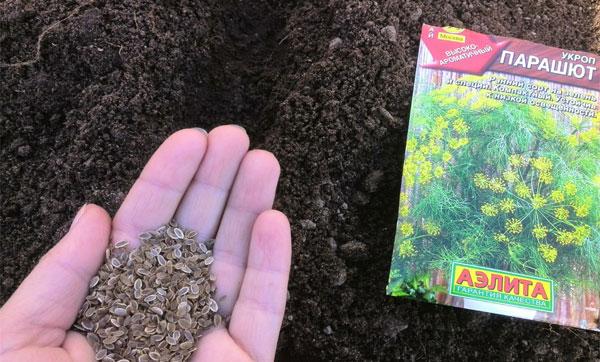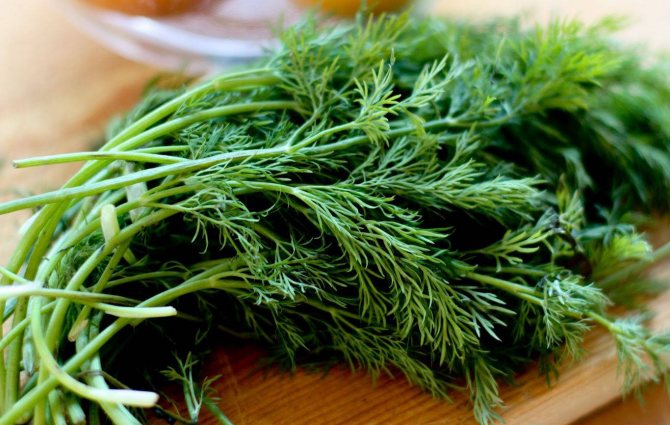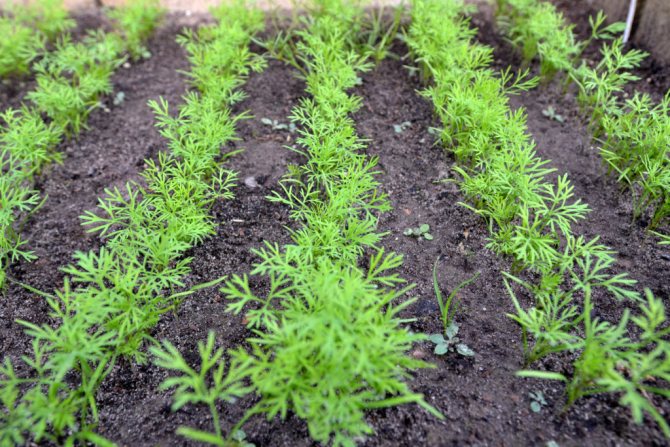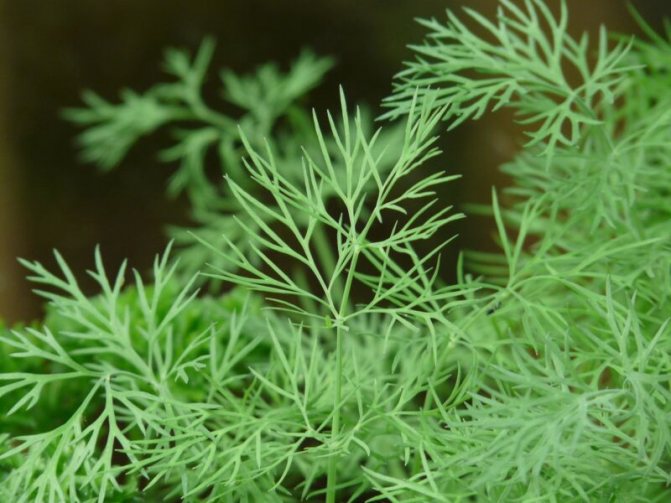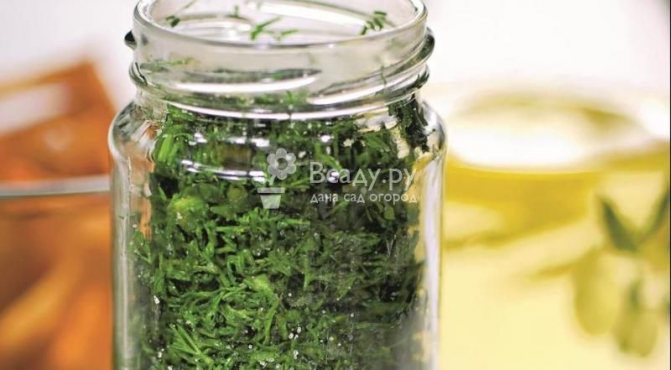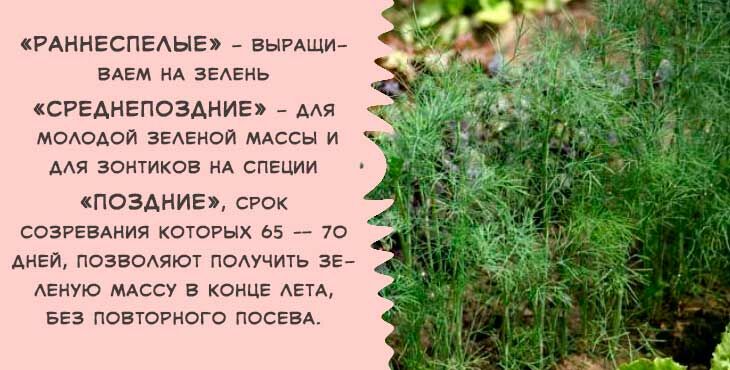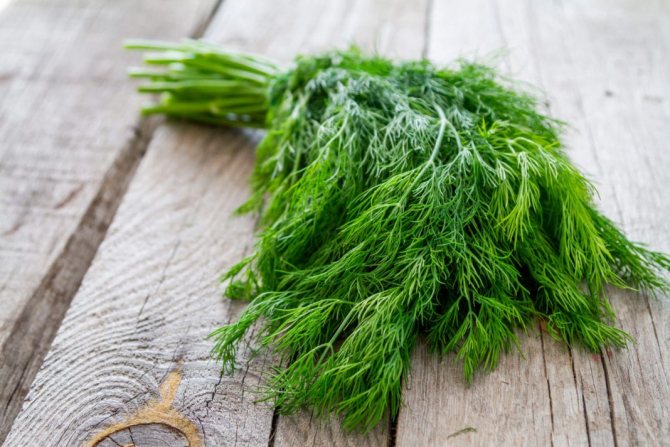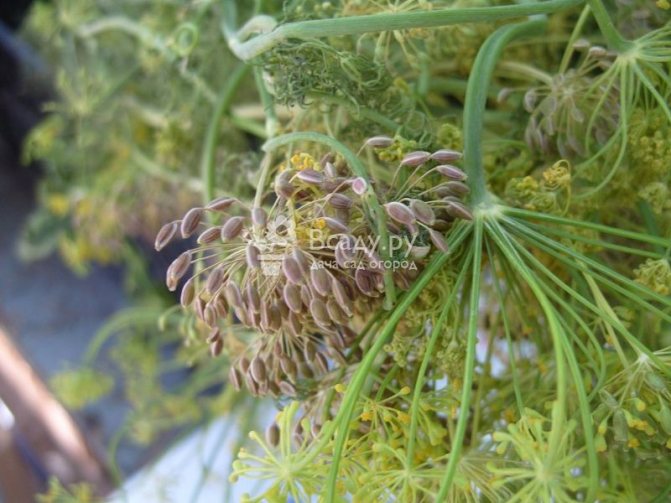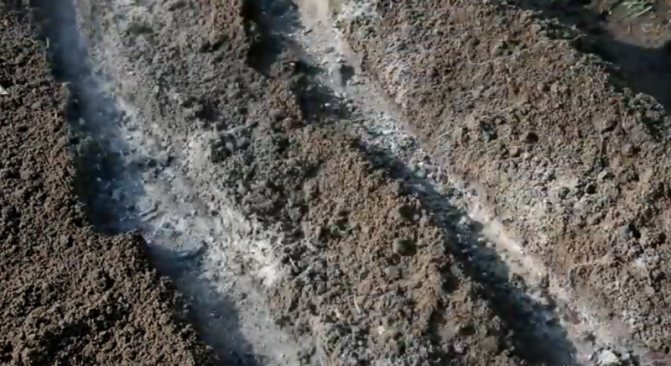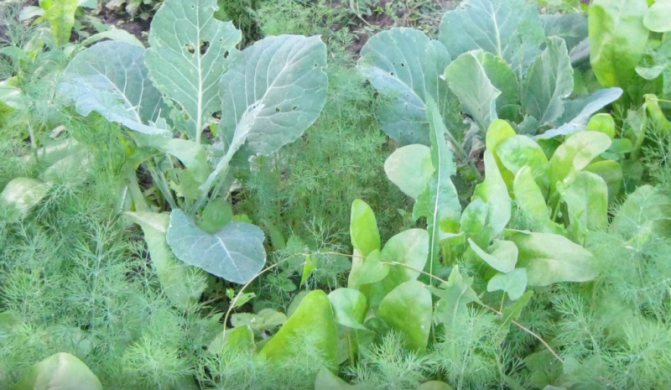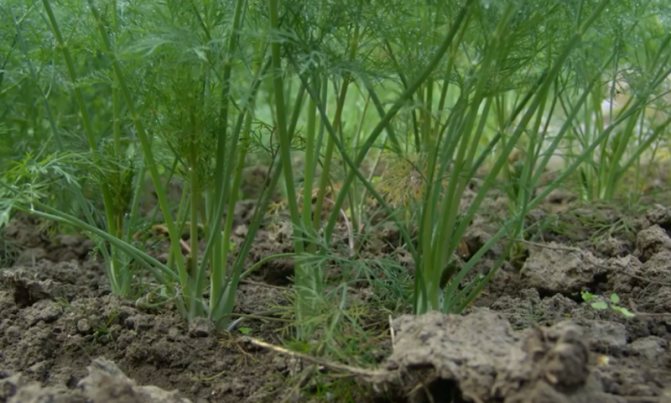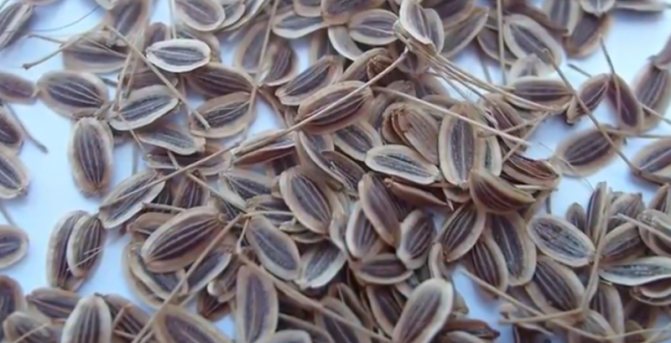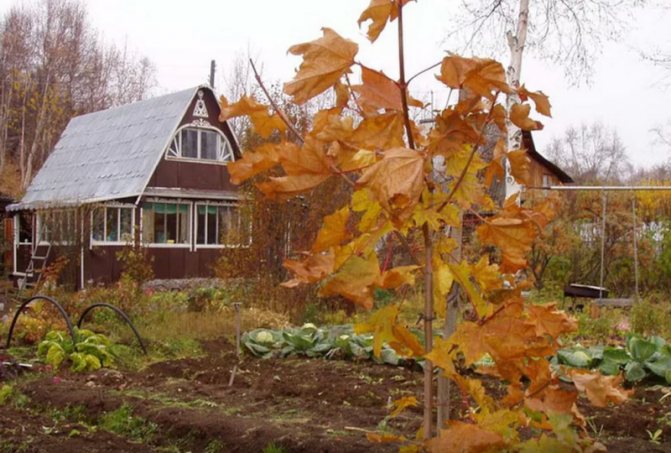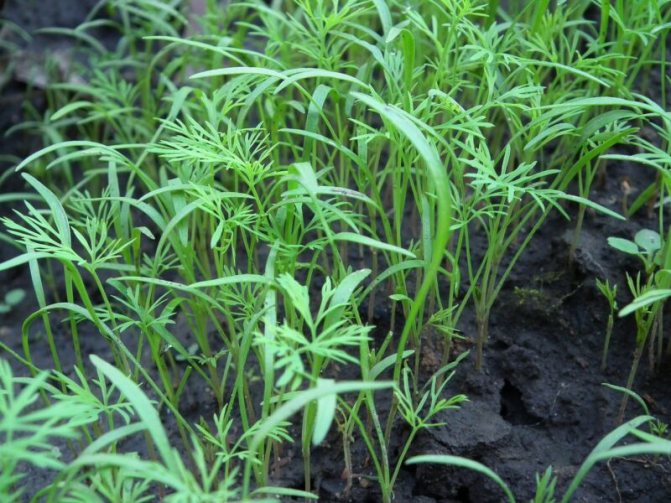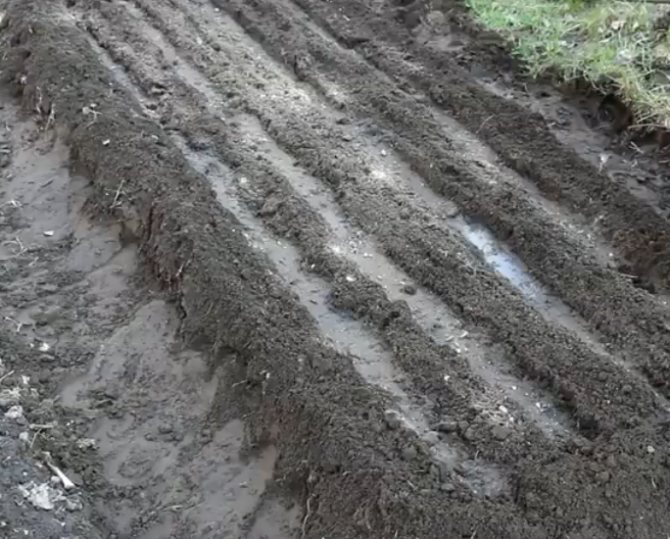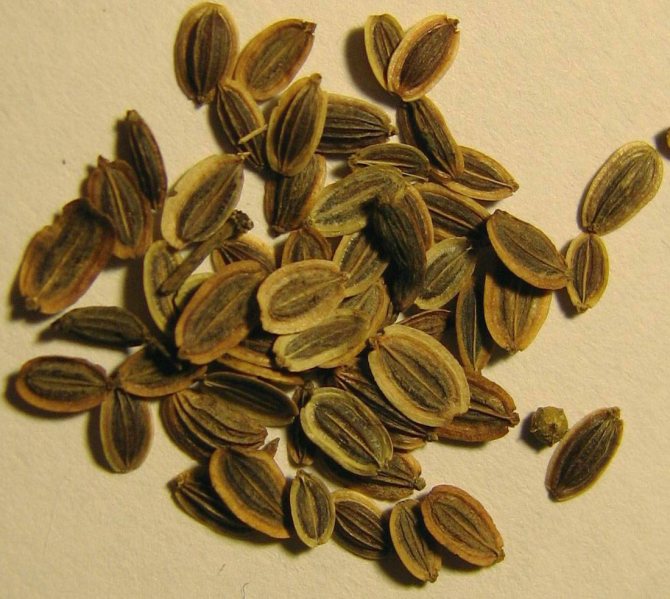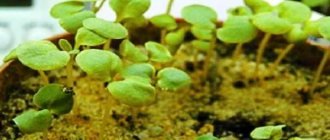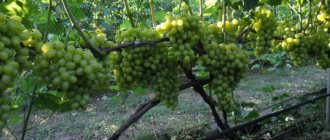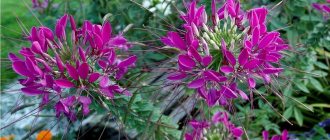I can't imagine my diet without greens! I'm sure you love it too, when the dish is decorated with a spicy aroma and taste of dill. Songs and legends can be composed about its value in cooking. But today I want to go in a slightly different direction. Before we figure out the intricacies of growing this crop, let me tell you about the benefits of the plant for women.
I'll start with what almost every mom knows, and then I'll tell you in general terms about the benefits:
- When your baby is worried about the tummy, he coughs or suffers from enuresis, it is the decoction of dill seeds that helps. It should be noted that even newborns can use a decoction.
- After childbirth, the broth helps mom to restore the pelvic muscles.
- For the general condition, and to strengthen the immune system, it is recommended that women use this particular herb and a decoction of the seed of this plant.
- But not only pregnant women and women in labor are useful to use this greens (and its seed). This plant acts as the very first aid in menopause and menstrual cycles.
- Strengthens the nervous system; helps to cope with stress.
- Improves brain performance.
- It has a beneficial effect on the condition of the skin and hair. Masks, baths, hair rinses and facial tonics are prepared from the plant.
Growing dill on your own means always having a first-aid kit, cosmetics, and an excellent spice for many dishes at hand. By the way, it stays well throughout the winter. It remains to find out how to grow a plant.
Varietal variety of dill
When choosing a variety, pay attention to the ripening time of the crop.
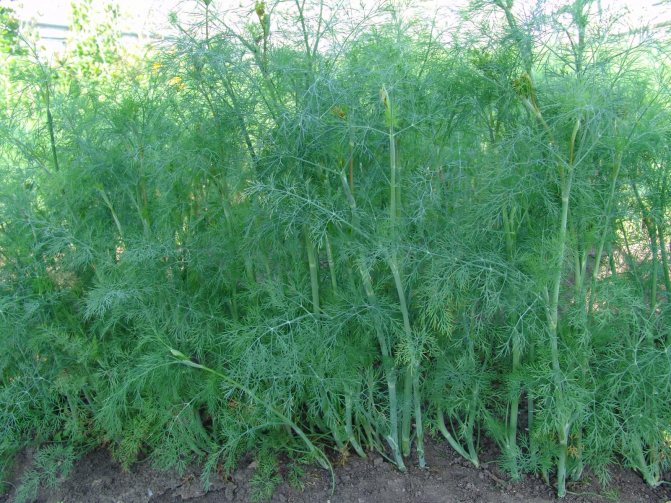
All varieties are divided into early, medium and late ripening.
- Early varieties. You won't get a lot of green mass for sale from them, although dill will be enough for cooking. The varieties are good for use in conservation, as they bloom and ripen quickly. Dill is sown in early spring, covered with foil. After 1.5 months, you will already have a harvest. The early varieties include Gribovsky, Umbrella, Grenadier.
- Medium varieties, for example, Umbrella, Richelieu, Uzory - ripen 2 months after sowing the seeds. They give more greenery - up to 10 branches. Suitable for the preparation of spices, and for freezing for future use, for sale and for use during the conservation period.
- Late ripening. The most productive are the late varieties - Alligator, Salyut, Buyan, Aurora, Kibray. They provide lush, luxurious greens that can be used not only for preparing family meals, but also for sale. You will get the harvest in 2-2.5 months after sowing.
Late bush varieties. They do not have umbrellas for a long time, new leaves grow quickly, which can be constantly cut off throughout the season without constantly sowing new seeds. These varieties are characterized by close stem internodes, so they look like small bushes, which is where their specific name comes from. Not all late varieties have time to ripen in the beds and give seeds. But they have green, juicy, fragrant leaves that can be used all summer.
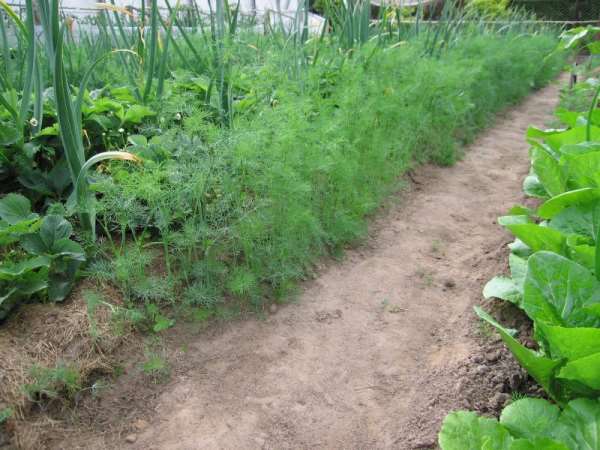

When to sow dill in open ground in spring with seeds 2019
The main indicator that it is time to sow dill is the air temperature + 3⁰.It should be borne in mind that dill prefers to grow at freezing temperatures. That is, if in your region the threat of prolonged frosts exists even in April, it is worth postponing the planting to May. But at the same time, small frosts, when the temperature does not drop below -5, dill can safely transfer.
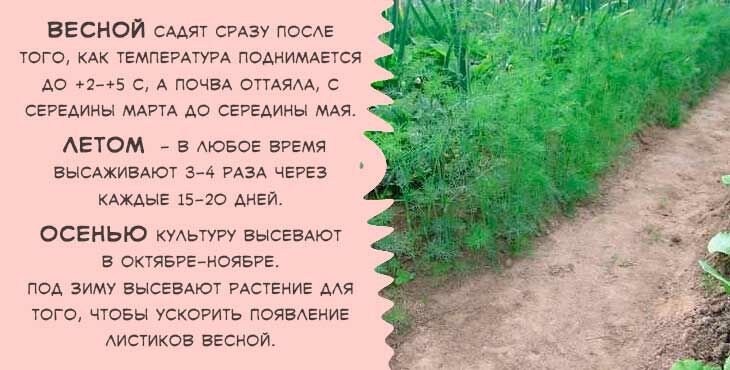

Planting dates range from mid-March to mid-May.
According to the lunar calendar 2019, the following days are considered safe:
- February - 6-8, 15-17, 23-25.
- March - 8-12, 15-17, 27-29.
- April - 6-13, 15-18, 24-26, 29, 30.
- May - 1-4, 8-10, 12-14, 17, 18, 21-23, 26-31.
- June - 5, 6, 9-15, 22-25.
- July - 10-12, 20-22, 29-31.
- August - 2-8, 11-13, 17, 18, 26-28.
- September - 1-5, 7-10.
- October - -.
- November - 1-3, 6-8, 15-18, 24, 25.
You can sow dill in spring, autumn and summer. Only summer crops are more suitable for obtaining seeds.
Choosing a place for planting greenery
For planting and caring for dill in the open field, you should choose a sufficiently illuminated place or partial shade in the garden. In the shade, it will not actively grow. The culture is fully developing on acid-neutral soils. If the soil is acidic, the dill will turn red, on alkaline it will turn yellow. The soil must be loose and fertile; on poor soils, the crop will not work. For planting dill, choose a high, not low-lying place. For sowing, it is advisable to prepare the land in the fall. It must be dug to a depth of 20 cm, organic and mineral fertilizers applied. Liming of acidic soils is carried out. When digging in the spring, add 20 g of urea, potassium salt and superphosphate. Consider the rules of crop rotation before choosing a place:
- You can not sow the plant where the umbrella grew last year - carrots, parsley, caraway seeds, fennel, parsnips.
- Umbrella are also the worst neighbors for dill.
- Good precursors of greens are cabbage, beets, potatoes, cucumbers, legumes, and tomatoes.
- Dill is a plant that favorably affects the development of some vegetables. When planting, keep in mind that the neighborhood of the culture will improve the taste of cabbage, and increase the duration of picking cucumbers. Spice adjoins well with potatoes, beets.
The influence of the umbrella plant will adversely affect the development of tomato, carrot, fennel, sweet pepper.
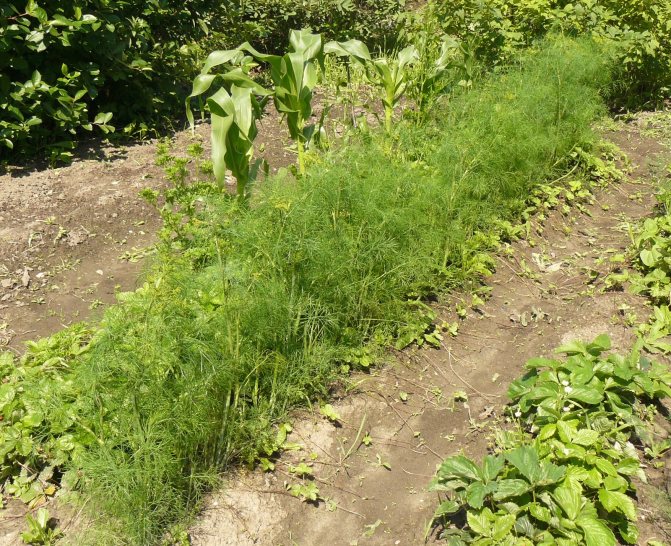

How to grow dill in the country in the open field from seeds
Dill is known for its "forays" into the beds. It spreads well by self-seeding. Does this mean that you can not worry about planting crops? Of course not.


In order for dill to give a good harvest and not get sick, you need to create conditions for it:
- The bed (or planting site) should be well lit. Culture needs sunlight and warmth for full growth and development.
- Almost all crops can be predecessors and neighbors, except for celery and fennel (if you want to collect dill seeds).
- If the planting of dill is planned among other plants, you need to make sure that other crops do not obscure the spice and the dill gets food: water and top dressing.
- The dill bed must be prepared in advance: cleared of weeds, fertilized with humus and dug up. For spring plantings, it is worth preparing the soil in the fall. For winter, a couple of months before sowing.
- In winter, you need to collect and hold snow in the garden.
- In the spring, carry out light weeding and cutting of furrows 1.5-2 cm deep.
- In case of insufficient soil moisture, the garden bed should be filled with water several days before planting.
If you decide to allocate a separate area for planting greens, you can sow dill and parsley alternately.
How to choose the time to sow seeds
Lovers of fresh greenery can sow seeds before winter, in winter, in early April.
- When sowing before winter, the material is deepened by 4 cm into the ground.
- In winter, you should clear the bed of snow and scatter seeds over the surface. Pour a mixture of compost and soil on top. The seeds will begin to germinate when the snow melts.When the bed is free of snow, cover it with foil.
- A frost-resistant crop is sown in early April to a depth of 0.5 cm.
To obtain greenery during the spring-autumn season, they practice constant sowing of seeds every 10 days.
When to sow dill before winter
Important! Sowing of dill is carried out in October-November, BEFORE the beginning of frost and freezing of the soil.
But even in this case, it is worth making the furrows for planting deeper than with spring sowing. The optimum depth should be 3.5cm.
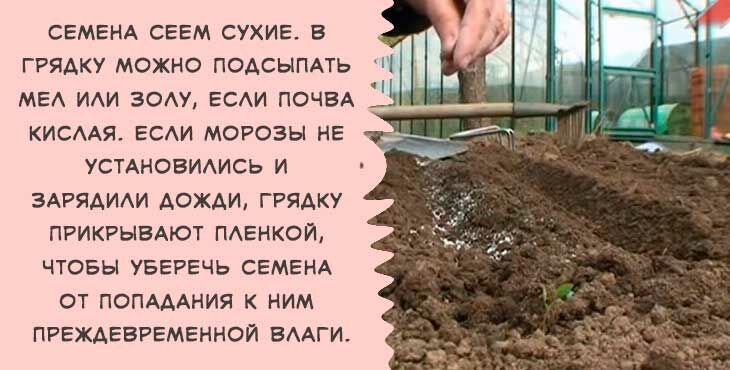

If, in the classic spring scheme, the seeds are planted to a depth of 1.5-2 centimeters, then before winter the depth should be 2 centimeters more.
At the same time, 25% more seed is used in order to obtain good germination of the crop.
Do not germinate or water the seeds!
When dill is sown before winter, the rows are not watered before sowing. It is even harmful (unexpected warming of the weather in the fall can cause premature germination of seeds). And in the spring, these seeds will have enough moisture from the melted snow.
Before winter itself, it is recommended to insulate the beds with some kind of mulch.
In early spring, with night frosts, dill will not suffer, since it has undergone stratification, its seeds start growing even at +30 C, and short-term drops in temperature are not afraid of it.
Preliminary preparation of seeds
Dill seeds saturated with essential oils may not germinate for a long time. To speed up the process, as well as to disinfect the seed, it is necessary to perform a set of measures:
- Go through the material, selecting dry, irregularly shaped specimens.
- Soak the seeds in warm water (about 50 degrees) for 3 days, changing the water regularly.
- Put on a wet cloth, stand until sprouts appear.
- Dry. After drying, the seeds are ready for sowing.
Growing dill from seeds at home on a windowsill
How to plant dill on a seed window sill?
- Prepare containers for growing. For this purpose, plastic containers with holes for draining excess liquid, installed on pallets, are best suited.
- Dill from seeds on the windowsill will grow lush and fragrant if the soil for planting consists of several layers. The first (small) - drainage from small pebbles, crushed stone or expanded clay. The second (small) is made of medium sand. The third (main) - from a nutritious fertile mixture;
- It is good to moisten the soil intended for planting dill seeds at home;
- Make grooves one centimeter deep, spill them with water, sow prepared seeds;
- Sprinkle the grooves with dry soil, this will protect the sowing surface from the formation of a crust that interferes with seedlings;
- Cover the "plantation" with foil, put in a dark place for seven days. The temperature regime should be approximately plus 20 degrees.
Features of sowing dill
For sowing, you will need to make grooves with a row spacing of 15-20 cm, a depth of 2 cm. Shed the grooves with water first. Sow the material with a row spacing of 1-2 cm, water. Dill seeds germinate at a temperature of 5 degrees. To accelerate germination, cover the crops with foil or agrospan. Expect sprouts in 1-2 weeks.
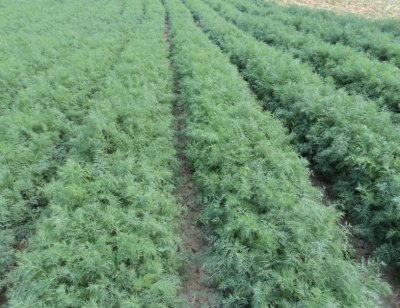

Is it possible to sow dill before winter
In terms of planting, I indicated autumn. Yes, you can plant dill before winter. This helps to accelerate the appearance of green mass in spring. Harvesting can be done 2 weeks earlier than with spring plantings. In this case, the greens will be stronger and more lush.
The best time for podwinter crops is with the establishment of stable autumn cold weather. In many regions, this period falls precisely at the end of October-beginning of November.
Although autumn crops can be done later, until the appearance of a permanent snow cover. As a rule, at this time the top layer of the earth is already freezing.This is not at all scary for seeds, but it can significantly complicate the preparation of the soil in the garden for sowing. Therefore, try to make a seedbed early or prepare the furrows in the flower garden (before the ground freezes). And also pre-stock the substrate with which you will sprinkle the sown seeds.
Seedling method of growing greens
They practice planting late bush varieties in a seedling way. When growing seedlings, follow the sequence:
- First, you need to sow seeds in March for seedlings in the beds in the greenhouse or boxes at home.
- Upon reaching 2-3 true leaves, you can make a pick, which the dill tolerates perfectly.
- Seedlings with 3-5 leaves are transferred to an open bed about a month after sowing. The transplant is carried out in the evening or on a cloudy day to avoid damage to weak seedlings by the sun's rays.
- The distance in the row between the shoots is 10 cm, the row spacing is 20-30 cm.
- After planting, watering is carried out.
- For several days, it is necessary to protect the delicate and weak seedlings from the rays of the sun. To do this, cover the seedlings with paper, agrofibre.
The seedling method speeds up the harvest time. After a week, spices can be removed from the bushes that have taken hold.
Description, varieties and varieties of dill
A plant from the umbrella family in the wild can reach one and a half meters in height. Cultivated species are grown both in the garden and on the windowsill.
The culture is used not only as a seasoning. Juices, infusions and decoctions have a positive effect on the heart, liver and genitourinary system.
Among themselves, the varieties differ in the time of stem formation, the shape of the rosette, color, and the splendor of the bush.
Fast stem formation means that the plant will form many umbrellas in a short time.
In early maturing dill, the period from sowing to flowering in the conditions of the Moscow region takes on average 35 days. It is necessary to pick ripe greens in a timely manner.
The culture develops equally well in greenhouses and in open beds.
Immediately after ripening, the plant enters the flowering phase, it is excellent for growing for seeds. The next spring, the crumbling seeds germinate well.
Popular varieties:
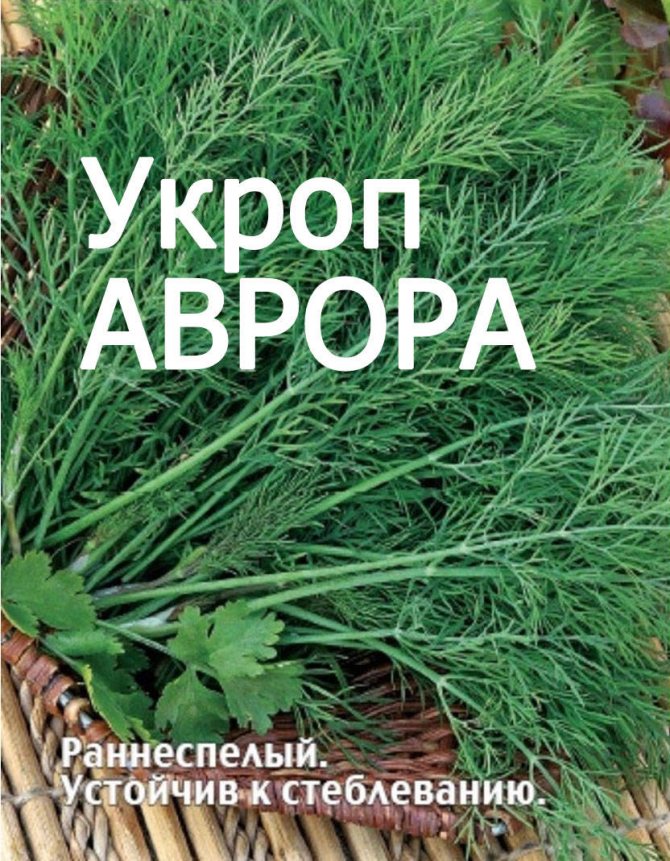

"Aurora". A small bush with dark green leaves. The ripening time for greens is 30 days. Forms inflorescences late. Grows well in shaded areas, disease resistant. Used in salads and canning.
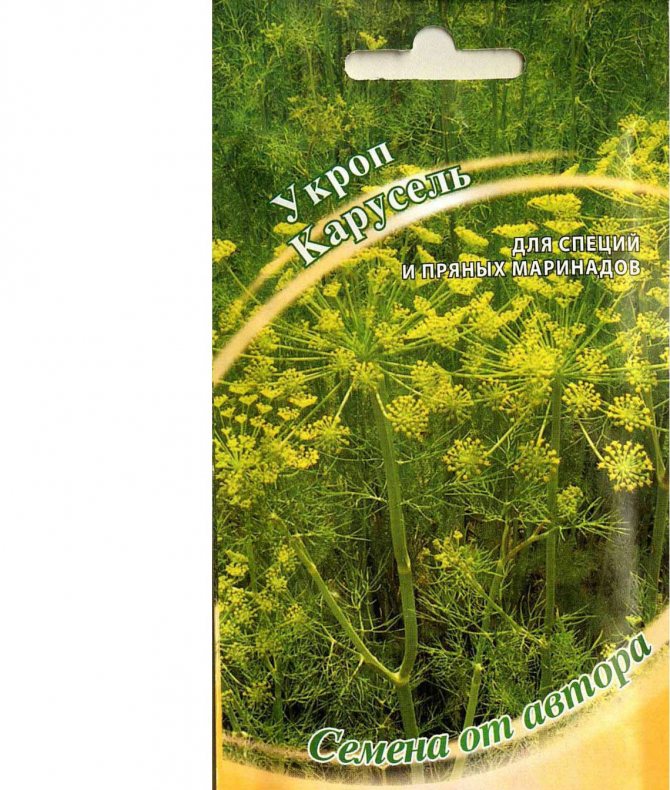

"Carousel". The bush is of medium height and has a strong aroma. It takes 40 days for greens to ripen. After another ten, umbrellas begin to form. Ideal for canning.
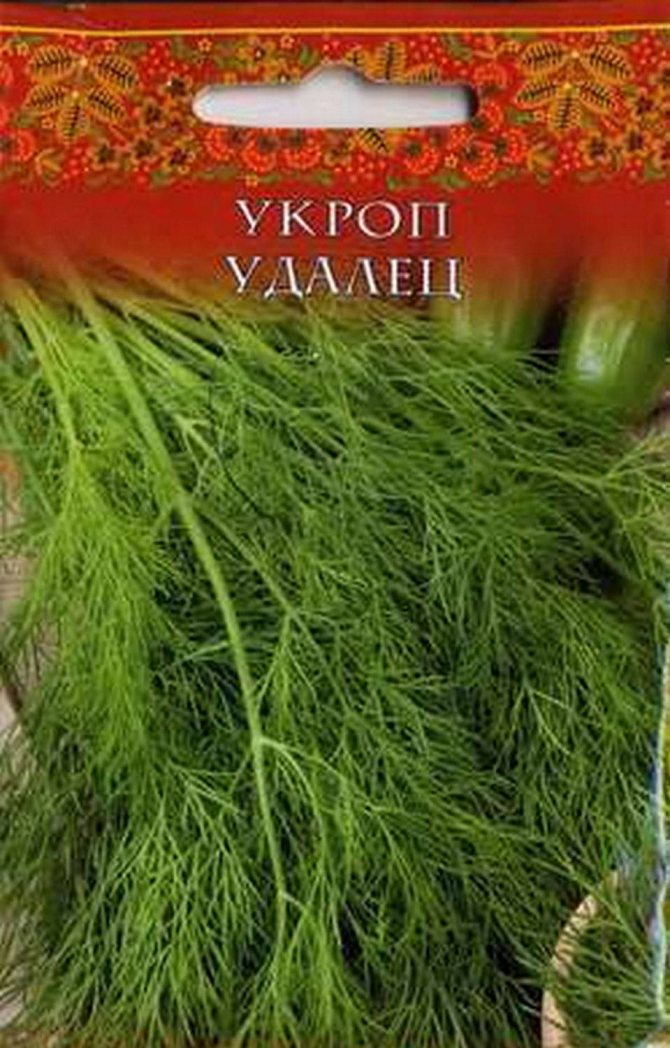

"The Utter". Early ripe dill for greens. The ripening period is 35 days. The green leaves are large and juicy.
Mid-season varieties have a longer ripening period.
This means that more green mass grows, and the umbrella is formed much later. The group is the highest yielding group of all.
Popular varieties:


"Hercules". The best dill for herbs. A powerful bush with a high yield. Leaves grow back after cutting. The variety blooms late.
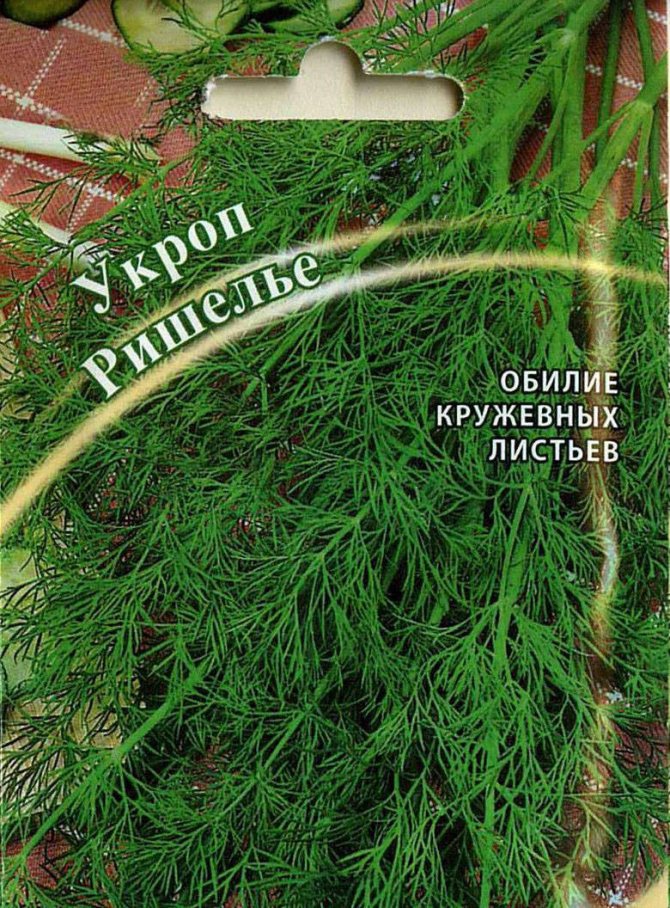

Richelieu. The bush has a bluish green hue. The foliage exudes a strong aroma. The variety is resistant to diseases and pests.
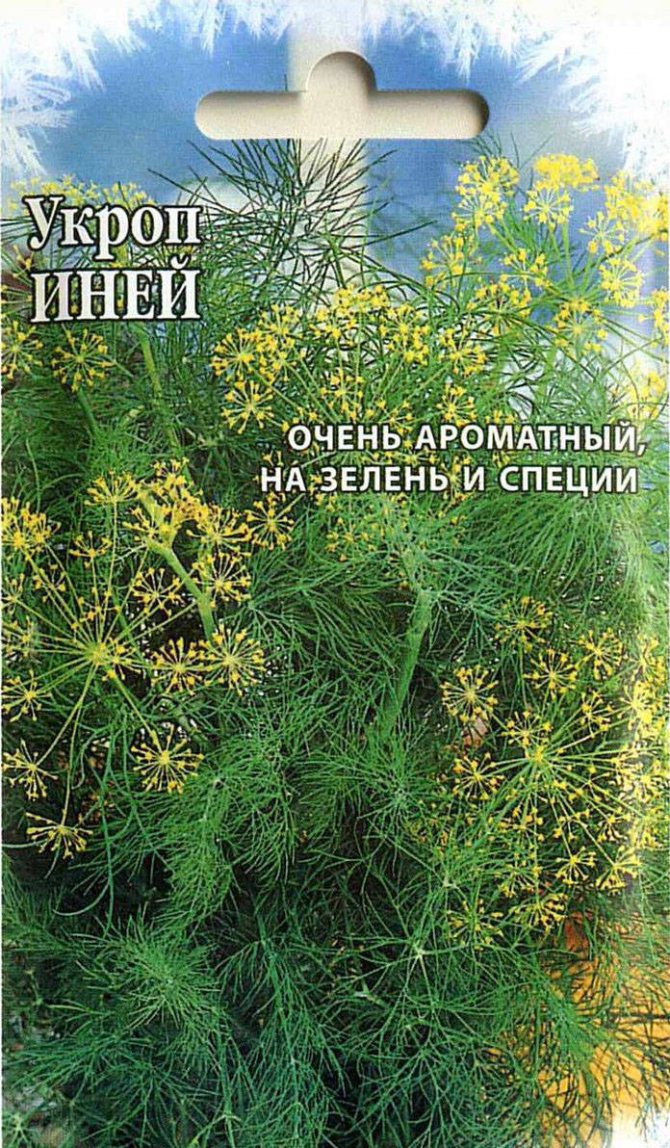

"Frost". Bush dill, very spreading. Collect both greens and umbrellas. Retains flavor and texture well when frozen.
Late-ripening species are distinguished by a long period from germination to stemming. The plant gives a large harvest of greenery.
Summer residents prefer late dill. Popular varieties:
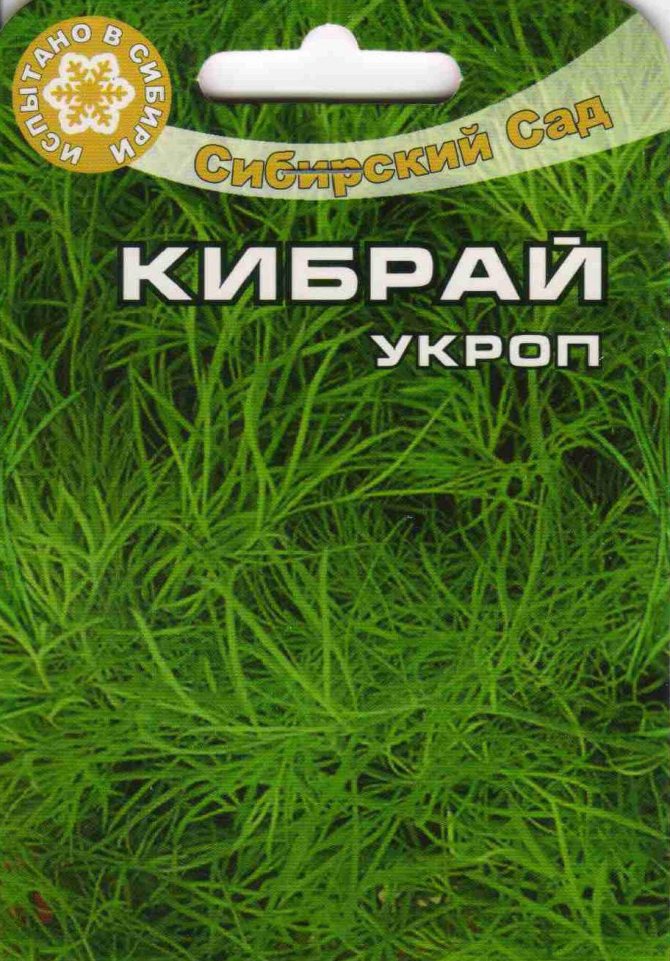

"Kibray". Bushy dill, the height of one plant is 40 cm. The foliage has a spicy aroma. The variety is resistant to disease.
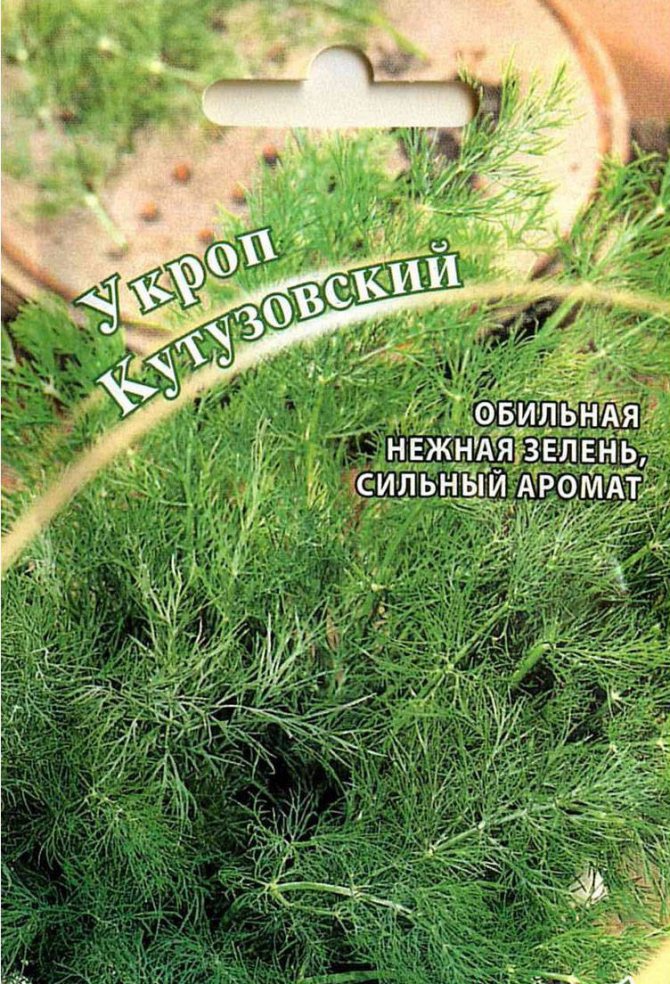

"Kutuzovsky". A plant with large leaves. The greens are cut off within a month. The variety is appreciated for its special aroma, it is recommended for drying, freezing.
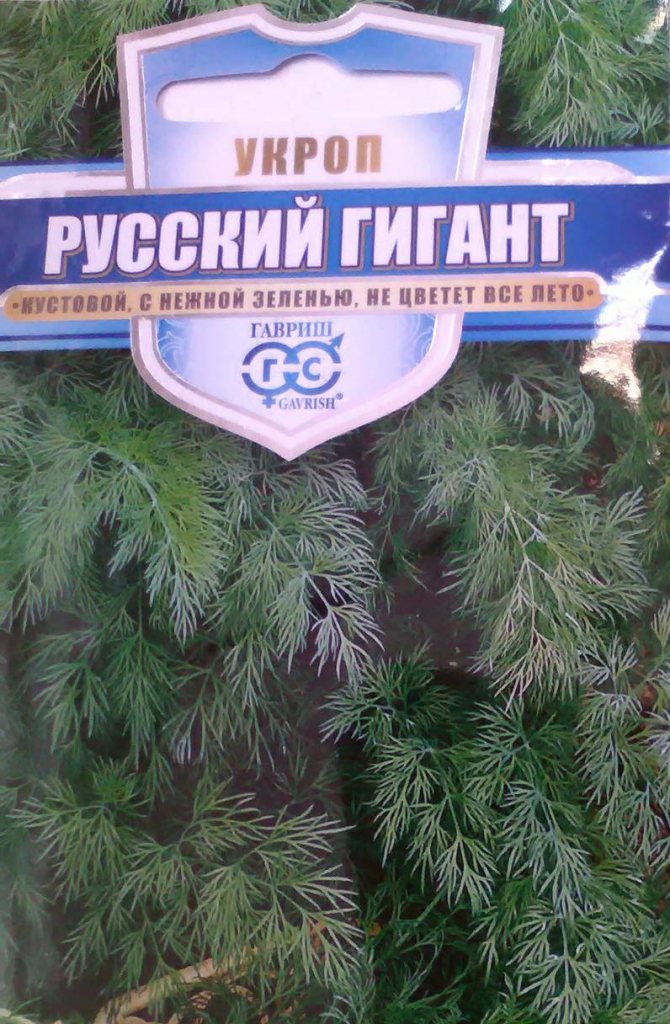

"Russian giant".Great for greens. The foliage is large, raised. The green mass is very juicy. Umbrellas take a long time to form, due to which the fruiting period increases.
Umbrella crop care technology
If you want to have greens throughout the spring / fall season, you should continually sow the seeds every 2 weeks. Seedling care consists in watering, weeding, loosening, thinning (at the same time harvesting), fertilizing, and protecting against pests.
- Watering should be abundant (20-30 liters per square meter), since in its absence, the taste of the spice decreases. It is advisable to water in the evening or in cloudy weather. In dry weather, 2 waterings are organized per day.
- The first weeding is carried out after the rooting of the plant. While the seedling is thin and weak, it is required to free it from weeds more often. Further, if necessary, approximately every 2 weeks.
- Loosening is performed after rooting of seedlings, loosened to a depth of 5 cm to remove the crust after watering. If the soil is loose, loosening is not required at other times.
- Thinning of dill is mandatory. If seedlings interfere with each other, they bloom faster, the growth of greenery stops.
- It is advisable to apply fertilizer in advance, before planting. Fertilization during the growing season is not done, only feeding will be required in case of insufficient plant development. For example, if you see that the bush turns yellow, it means that there is a lack of nitrogen and it is necessary to add urea - 1 tsp. 10 liters of water, 1% mullein solution.
Phosphorus-potassium fertilizers are also introduced - 10 mg per square meter, also preferably before planting. Pay attention to the nitrate accumulation property of dill. As a substitute for fertilizers, you can use nettle infusion, fermented for 5 days (used as a means to combat aphids).
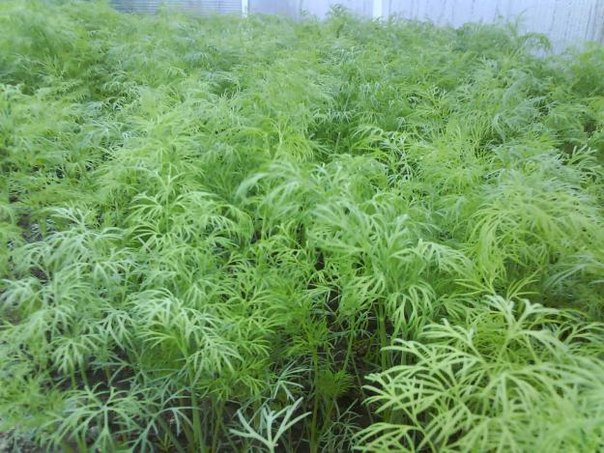

Growing dill in winter
Growing dill on a windowsill requires an additional light source, but otherwise is no different from the method described above. To compensate for the lack of natural light due to the reduction in daylight hours in the autumn-winter period, incandescent or daylight lamps located at a height of ½ meter from the shoots are suitable. If dill, in winter, is grown on a windowsill, the additional illumination period is six hours a day. The optimal temperature regime should be within +18 - +20 degrees. It is recommended to fertilize the soil with mineral fertilizers a couple of times a month.
How to harvest correctly
Dill greens, mature preservation plants and seeds are harvested. The plant is cut only at a young age. As soon as the umbrella appears, the greens are no longer suitable for cutting. The seedling is then left for seed, for making spices, or for use during conservation. During the harvest of greens, the following rules are followed:
- First, the rows of young seedlings are thinned out.
- During development, until it reaches full maturity, you can remove a few leaves from the dill for food, but leave enough for normal functioning.
- Before flowering, the entire plant is removed from the root.
In bush varieties, in which the umbrella does not appear until 50 days, the period for collecting greens is quite long. First, the lower tier of the bush breaks off, a rosette is left for regrowth. Then the lateral shoots are plucked out of the sinuses, and then the whole bush is collected. In some late varieties, the bush may not mature before seed formation. The green part is harvested until late autumn. So, the dill is ripe. The seeds in the umbrellas turned brown. It's time to collect them. After collecting them, they will need to be dried. Dill seeds retain their germination capacity for up to 3-4 years.
When to plant dill for seedlings
Why is it worth growing dill seedlings? To get earlier harvests. After sowing dill for seedlings, 35 days should pass, and then it will be possible to relocate young plants to a permanent place of growth in the beds.This means that you can start sowing dill for seedlings from the end of March in order to transfer the plants to the ground, when there is still moisture in it.
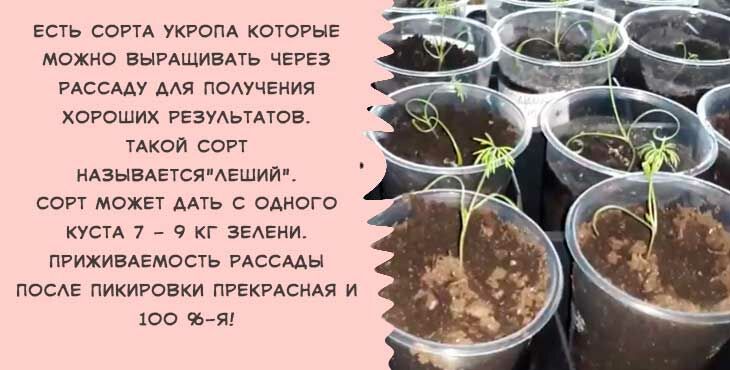

If you have any questions or suggestions, leave a comment! Then our article will be more complete and informative.
The conversation about the garden and about the work in the garden continues. Subscribe to find out topics of new articles. And don't forget to look into our previous conversations where we talked about radishes, spinach and salad. Become an active participant in these articles, post links to them on your social networks!
Specificity of the protective system of dill
Dill is a fairly resistant crop against diseases and pests. The plant contains a large amount of essential oils, which can be judged by the strong smell of dill. Please note that the use of insect preparations on dill, which can be cut off for consumption at any moment, is undesirable. Therefore, preventive measures are of particular importance.
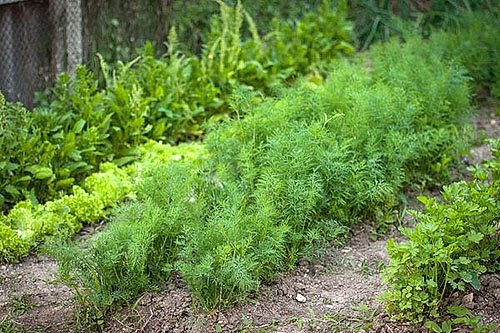

Harvesting and storage
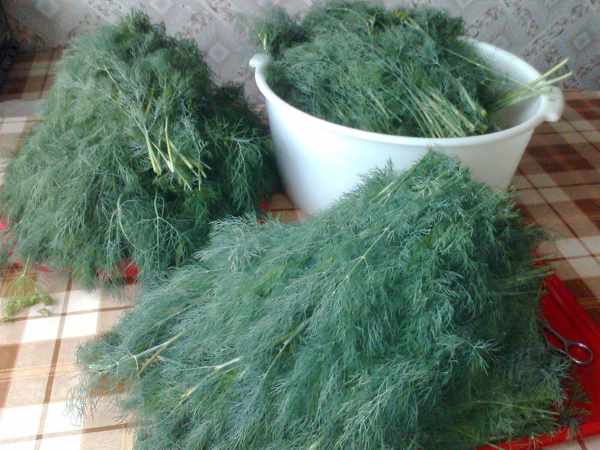

Young dill
can be eaten immediately. For harvesting for the winter and storage, collect the dill after the inflorescences have formed. The height of the plants is at least 30 cm. It is better to harvest dill early in the morning, as the dew disappears. Plants may wilt a little during the day.
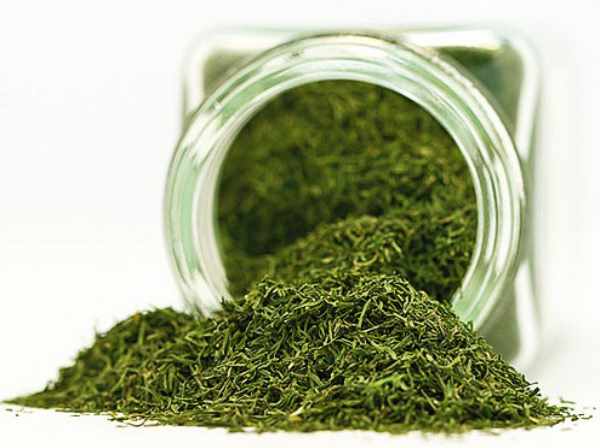

You can store dill in different forms. For dry storage, wash the harvested dill pieces and dry in the shade, turning the dill periodically. Then we put it in fabric bags and store in a dark place.
If you store plants with umbrellas, they are tied in bunches and kept hanging in the winter.
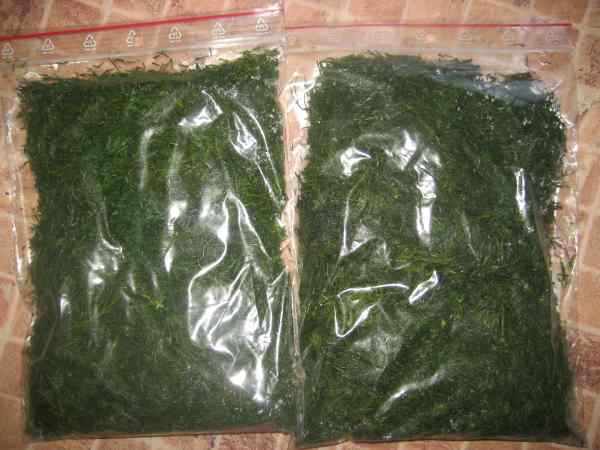

Young, juicy greens can be frozen for the winter. To do this, rinse the cut pieces, dry, chop finely and store in zip-lock plastic bags in the freezer. This is great for adding dill to your meals in winter.
Video - How and when to sow dill
Preventive measures against diseases of umbrella crops
Preventive work against diseases of dill is largely consistent with the general measures for the prevention of diseases of vegetable crops. Follow the main points outlined in the checklist:
- Follow the rules for changing crops.
- Timely carry out the autumn-spring cleaning of the remnants of previous plants.
- Collect seeds from healthy specimens.
- Warm up the seed for decontamination.
- Observe the technology of growing the plant.
- Kill weeds regularly.
Care after landing
Despite its unpretentiousness, dill needs proper care. Providing the plant with a comfortable environment will surely delight you with a bountiful harvest.
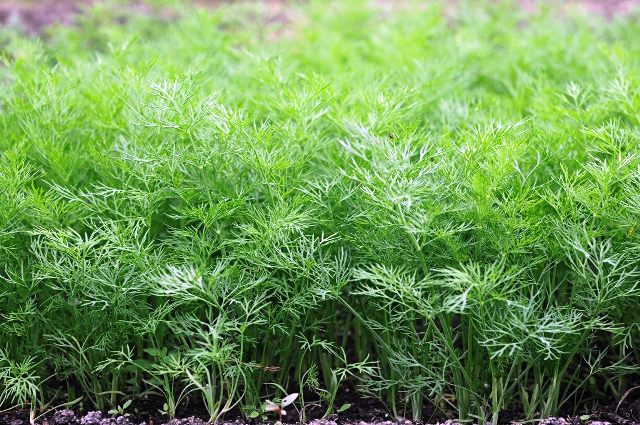

Watering
Do not overdry the soil in the dill garden; it should always be slightly damp. But do not turn the garden into a swamp, otherwise the plant will get sick and die. Drought is also harmful to the development of dill - the leaves will turn yellow, dry out and become unusable for food. It is best to water green spaces 2 times a week at 6-8 liters per sq. m in dry weather.
Top dressing
For dill with a short ripening period, the soil can not be fertilized, the plant will have enough what was introduced during the preparation of the garden. If dill grows slowly, it is fertilized with nitrophos or urea (10-15 g / sq. M). The same fertilizers are applied during the first feeding of mid-ripening and late-ripening varieties, when they have 2-3 leaves.
After 20-25 days, they are fed with potassium salt and urea (urea) at the rate of 3-4 sq. 15 g and 20 g of fertilizers, respectively. Make sure that fertilizers do not get on the leaves, and thoroughly water the beds after feeding.
Weeding and loosening
So that the nutrients do not go to the weed grass, but get useful greens, the garden is weeded. In addition, the weed root system compacts the soil and retains excess moisture.
The main diseases of dill and the fight against them
Among the main diseases of umbrella plants, a special place is occupied by fusarium, black leg, powdery mildew, peronosporosis, phomosis, cercospora, and rust.Basically, these are fungal diseases that develop with temperature drops, waterlogging, damage to roots, on poor soils, in violation of the rules of crop rotation.
Fusarium wilting
Leaves are affected, which gradually turn yellow, then darken, wither. To prevent the disease, the soil is pretreated before sowing with biofungicidal preparations (for example, trichodermine), stimulants, humates, micronutrients are used.
Blackleg
The root collar at the base of young seedlings turns black and rots, which leads to 50% death of seedlings. Apply a foundation solution. It is advisable to pre-treat the soil with biological products.
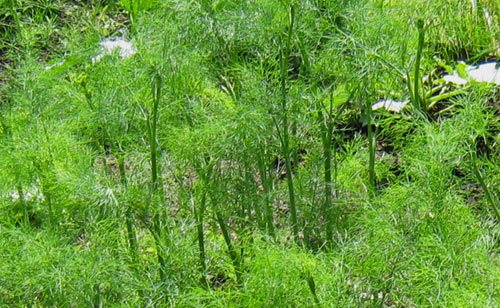

Powdery mildew
It affects the ground parts of dill, which are covered with a whitish bloom. The quality of the spice is significantly reduced. Almost after the development of the disease, the plant cannot be eaten. The planting should be treated with a 2% solution of colloidal sulfur (20 g per bucket of water).
Peronosporosis (downy mildew)
It affects the ground part of the plant, which externally manifests itself in the form of brown spots. It is recommended to use 4% copper oxychloride (40 g per bucket of water) or Bordeaux mixture (100 g of copper sulfate and lime per bucket of water).
Rust
Notice the symptoms of the disease on the leaves: yellow-brown pads with fungal spores will be on the underside of the leaf. It should be treated with 1% Bordeaux mixture or 4% copper oxychloride.
Fomoz
Its sign will be the appearance of brown spots on the ground part and root. It is necessary to treat the plants with a 1% solution of Bordeaux mixture. Spray several times with a break of 2 weeks, but no later than 2 weeks before harvest. Plants will need to be washed before eating.
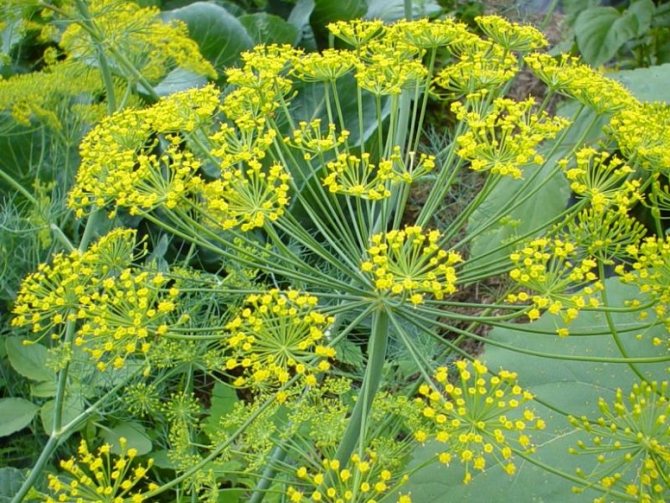

Cercosporosis
You can recognize the disease by the leaves, yellow with gray bloom, yellowish-brown spots. In autumn, black capsules with mushroom larvae are visible on the umbrellas. Please note that the antiseptic treatment of the plant is suspended at least 20 days before harvest. As for pests, dill lovers do not exist. Pests can infect the plant at the same time with others nearby. Therefore, you should just carefully monitor the garden as a whole when growing and caring for dill in the open field. Then the harvest will delight you and your loved ones with its juiciness, splendor, bright aroma and full composition of vitamins.
How to care when growing at home?
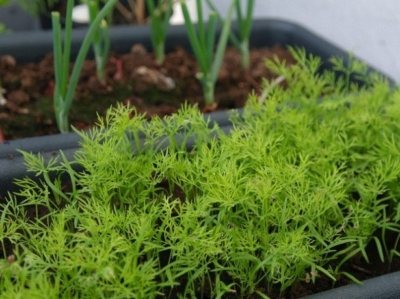

If it is not possible to grow dill in the garden, you can do it at home on the windowsill. In the open field, the crop grows thick and spreading on almost any soil. For home breeding, you should choose a fertile soil for indoor plants.
Dill needs a lot of light and space. Therefore, the growing container should be wide and deep, and the location in the most illuminated part of the apartment. Additional electric lighting can be used to increase daylight hours.
Dill harvesting
When harvesting, you must adhere to some rules.
- It is better to collect dill in the morning, after the dew dries. In hot daytime hours, greens tend to wither somewhat.
- The optimum height for cutting dill for greens is 10 cm. Plants usually reach this size in a month and a half after sowing. It is recommended to spray the greens with water before harvesting and then carefully cut with scissors.
- If you leave roots in the ground with an aerial part of about 2 cm, then after a while they will give new leaves.
- For subsequent use in preparations (pickles and marinades), some plants are left untouched until they reach milk-technical ripeness.
- If for quick use it is better to cut young greens, then plants that have already formed inflorescences and have reached a height of 25-30 cm are well suited for drying and subsequent storage.
- Dill must be dried in the shade, with good ventilation.Both seeds and the herbaceous part of the plant are suitable for storage. You can dry and then store the whole plants by tying them in bunches and hanging "bouquets".
- It is very convenient to store young greens in the freezer, laid out in layers in plastic bags and, if necessary, simply break off the required amount.
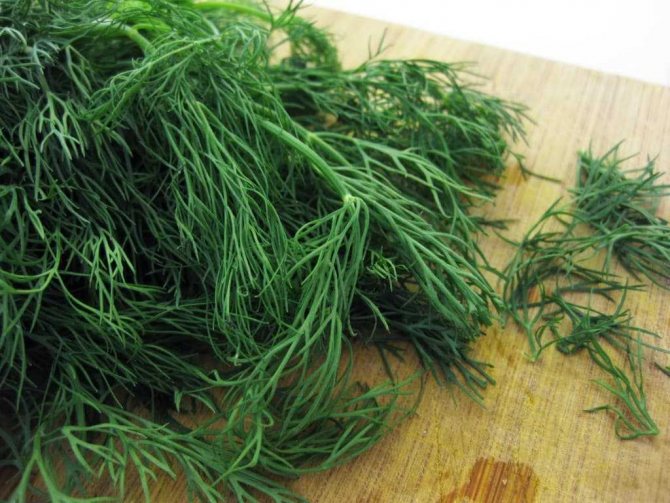

The earliest harvest is obtained from podwinter sowing, which is carried out with dry seeds at the very end of autumn.
Reproduction of culture
Dill reproduces very well by seeds. The plant blooms in June and July. The color of the flowers is yellow. After flowering, seeds are formed. Seed ripening occurs in autumn. One seed reaches 5 mm in length.
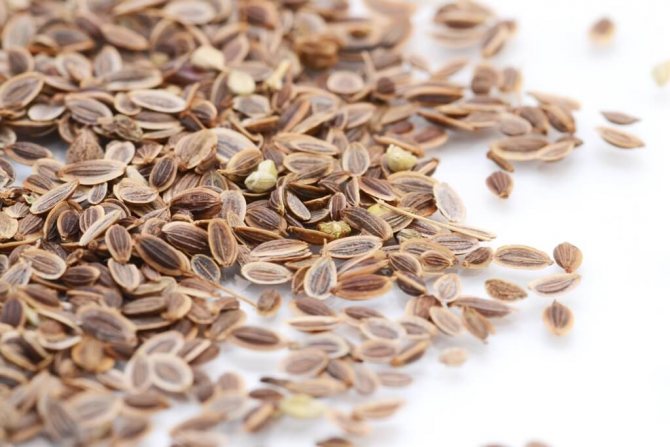

Dill seeds
When to plant carrots outdoors in spring
To propagate a crop, it is enough to collect seeds in August or early September, and plant them in the ground in April. The collection of material for planting is carried out as soon as the umbrellas have acquired a brown tint. This means the seeds are ripe. After collecting, they are calcined in the sun, and then placed in the oven for 5 minutes. The temperature there should be 80-110 degrees.
Important! How long can seeds be stored for planting? Experienced summer residents are sure that this period is two years. They winter best in tightly sealed glass jars or paper envelopes.
Sowing dill with seeds
Before planting dill, you should decide on the variety.
There are three varieties of this spicy herb:
- Early (the plant can be eaten within a month after planting);
- Medium (ripening occurs in 45 days);
- Late (greens can be crumbled into salads 2 months after planting).
The peculiarity of early varieties is that they are not too fluffy. But they are ideal for growing at home. Among the places where you can grow culture at home: windowsill, balcony. Known early varieties: Gribovsky, Redoubt, Dalny.
Medium varieties include Max, Alligator, Richelieu.
Late varieties ripen late, but this dill is lush, gives a lot of greenery. Spicy grass will decorate the garden with green fluffy thickets. Late varieties: Salute, Patterns, Hoarfrost. Planting these varieties of dill can be carried out not only by seeds, but also by seedlings. The seeds are placed in small containers with soil mixture. The container is left on the windowsill. An insulated balcony is suitable for seedlings. The seeds will sprout within a week and a half. After the bushes stretch up to 3-4 cm and get stronger, they can be transplanted to a permanent place in open ground or a greenhouse. It is fluffy dill that is most often grown commercially. Its sale brings a good income.
Additional Information. Dill contains vitamins of group B, PP, A, C, magnesium, potassium, phosphorus, calcium, essential oils, etc.
Home treatments can be done to speed up seed germination. For example, the seed is wrapped in damp gauze and left for several days. The gauze must be constantly moistened with water, not allowing it to dry out. It is best to soak where it is warm. The optimum temperature for the procedure is about +22 degrees and above. Another way to speed up germination is to soak the seeds for 3 days in a glass jar of water.
Usually sowing of dill in the spring is carried out in April, but you can plant a crop at any time. Autumn, spring, summer are suitable. You can plant a spice in July, then in August or September there will be herbs from the garden on the table. Planting before winter is allowed. In this case, the seeds do not need to be soaked. The lunar calendar will help you choose the right day for landing.
Before planting dill, you need to prepare a garden bed. The soil is dug up, weed roots are removed. If the land has been fertilized in the fall, no additional fertilization is required before planting.
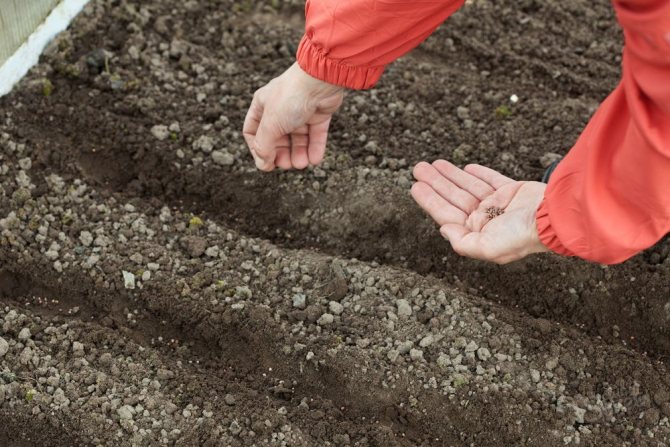

Sowing culture
There are some tips on how to sow dill so that it sprouts quickly:
- The soil should be rich in organic fertilizers.The best option is to add humus to the soil in the spring or autumn. Quantity - one bucket per 1 square meter of land;
- In spring and autumn, seeds are planted that have been previously soaked in water or wet gauze;
- The landing site should be on the sunny side of the garden;
- Before sowing dill, the garden bed is well moistened and left for several days so that the soil settles a little.
Dill planting process
In the spring
Dill can be planted on any garden bed: simple, mobile, high. Planting dill in open ground with seeds in spring takes place after prolonged frosts. The ridge needs to be shed and loosened. Further, shallow holes are made on it. It is most convenient to do them with a stick, which is placed on the garden bed and pressed a little into the ground. The entire area of the bed should be lined with these furrows, the distance between them is 20 cm.The optimal width of one furrow is about 5-7 cm.If a late variety sits, then the distance between the holes increases to 25-30 cm.
Seeds are sown into the resulting furrows. They are planted to a depth of 1-2 cm. The distance between seeds is 5-10 cm, for late varieties - 20 cm. It is not worth thickening the planting. It is allowed to plant 1-1.5 grams of seed per square meter.
The seeds are covered with earth, which is slightly compacted. There is no need to water immediately after planting so that the soil is moistened beforehand. Otherwise, the water can further deepen the seeds, which will be difficult to grow. No special care for the seedlings is required. For several days, the garden is not watered. As soon as the first bushes appeared, the planting must be thinned out.
In summer
How to plant dill in open ground with seeds in summer? The planting process is exactly the same as in the spring months. In general, in the summer, the culture can be planted every two weeks. It is convenient to do this if the dacha is located near the house. Then fresh herbs will be on the table for the whole season. It is allowed not to allocate a separate bed for greenery. Dill can be planted in a free area of areas where onions, cucumbers, cabbage or other vegetables grow.
Experienced gardeners know that planting dill in summer should not be done in a greenhouse, only in open ground. Otherwise, the spice may lose some of the aroma.
Another condition concerns seed soaking. Before sowing dill, the seed must be soaked. This will greatly speed up germination. The seeds will sprout in 4-6 days. Seedlings from dry seeds would have to wait more than two weeks.
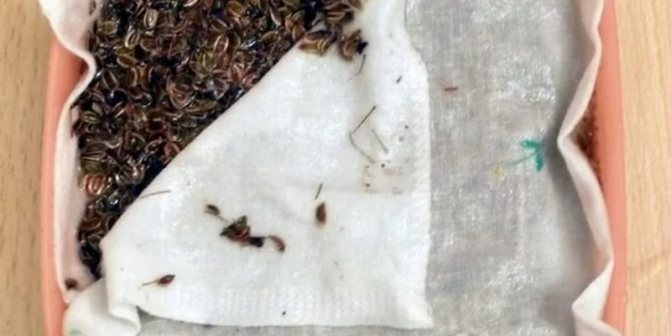

Seed soaking
In autumn
How to sow dill correctly before winter? The procedure is especially popular among gardeners. Thanks to this method, fresh herbs can be tasted already at the end of April. If the climate is Leningrad, then winter dill will ripen in May. The culture tolerates winter without problems. As soon as the soil starts to warm up, the seeds begin to germinate.
The right time for planting before winter is the end of September, October.
Landing rules:
- Before planting dill in the fall, it must not be soaked. The seeds must be dry;
- For one square meter, 2 grams are taken. seeds. They are planted quite often;
- The soil should be fertilized with humus;
- Sowing takes place to a depth of 3-5 cm. The distance between seeds is 3 cm;
- Sprinkle the seeds with loose earth, and then mulch. Sawdust, hay are suitable as mulch. It is better to cover the bed with a film. In the spring, as soon as the snow melts, the air temperature will rise to +5 degrees, the garden will have to be opened.
Preparatory stage
Each plant has certain conditions necessary for growth and development. Preparing the soil and dill seeds responsibly can help you harvest faster and improve quality.
Soil preparation
Dill loves to grow in a sunny garden bed or in partial shade. Choose a location where water does not stagnate, but is not too dry.
If in the previous year cucumbers, tomatoes, cabbage, beets or legumes grew on the selected bed, then it is not necessary to fertilize the soil. Dill will have enough nutrients left over from last year. Don't plant it after carrots, celery, parsley, and dill itself.
Good neighbors for a spicy crop are cucumbers, zucchini, cabbage and tomatoes. They are often planted together, but not too close to the stems of the plants, so that the dill does not take away water and nutrients from them.
To prepare the soil for planting, humus is introduced in the fall in an amount of 3 kg per square meter. m or any complex fertilizer. Then the land on the site is carefully dug to a depth of 20-30 cm and leveled with a rake. In the spring, wood ash is introduced into the soil 0.1-0.2 kg per square meter. m.
Important. For better seed germination, it is useful to fertilize the soil with superphosphate in an amount of 30 g per sq. m.
Seed preparation
Dill seeds are rich in essential oils. These oils prevent germination as moisture does not penetrate into the seeds. To improve the germination of dill, the seeds are poured with warm water and left for two days. The water is changed as it cools.
After that, the dill seeds are wrapped in a damp cloth and left for 2-4 days at room temperature until they sprout.
Preliminary preparation of seeds prevents the plant from diseases. Therefore, after soaking, the seeds are washed with a strong solution of potassium permanganate, then running water and then dried.
Variety selection
When choosing a variety of dill for planting, you need to carefully study its characteristics. The fact is that some varieties give abundant greenery, while others form flower stalks and are intended for collecting seeds. The types of this culture are distinguished not only by purpose, the height of the bush and the shape of the flowers, but also by the timing of ripening.
Early maturing varieties
These include:
- Gribovsky (30-45 days pass from germination to the first harvest of leaves). The culture is undemanding to weather conditions: even in cold summers, the bushes give a lot of high-quality greenery. You can plant seeds of this variety, starting in April and ending in July, several times. The height of the rosette of Gribovsky dill reaches 25 cm. The leaf weight of one plant reaches 1 kg. The variety is resistant to many diseases and pests.
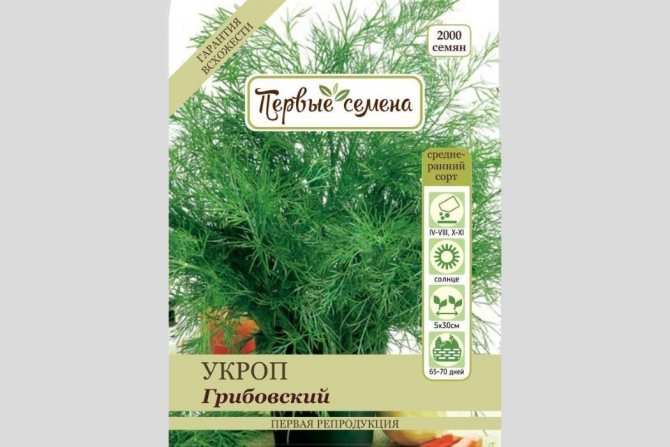

- Further (from germination to harvesting - 38-40 days). This is a productive variety: from 1 sq. m collect 2-2.5 kg of green mass. Dalniy dill is grown on an industrial scale for sale. A feature of the variety is the presence of a wax coating on the leaves. Distant is resistant to pathogens, tolerates showers without lodging.


- Redoubt (first collection - 1.5 months after seed germination). During the season from 1 sq. m collect 1.3 kg of leaves.
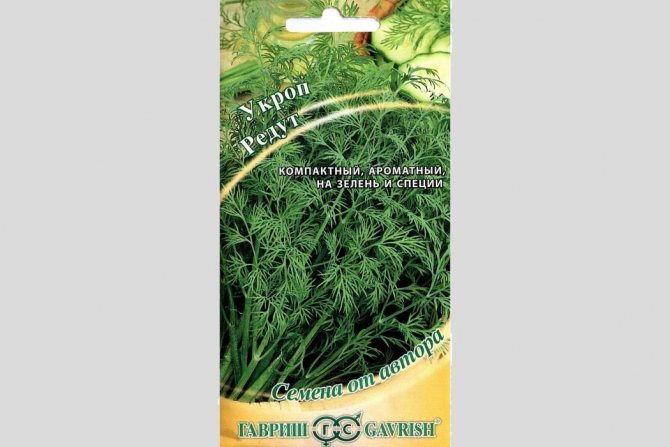

Early-maturing varieties quickly form umbrella-shaped inflorescences: they form faster than leaves ripen. That is why it is impossible to collect a large amount of greenery from them.
Mid-season varieties
Popular representatives of this group are:
- Amazon... It is recommended to sow the crop in late April and early May. The first collection of greens is carried out approximately 1.5 months after seed germination. During the season from 1 sq. m you can collect 2.5 kg of leaves.


- Max... Seeds of this variety are planted in the soil after it warms up to 8 degrees or more. Leaves can be harvested 1.5 months after seed germination. The total weight of deciduous mass is up to 4 kg per 1 sq. m.
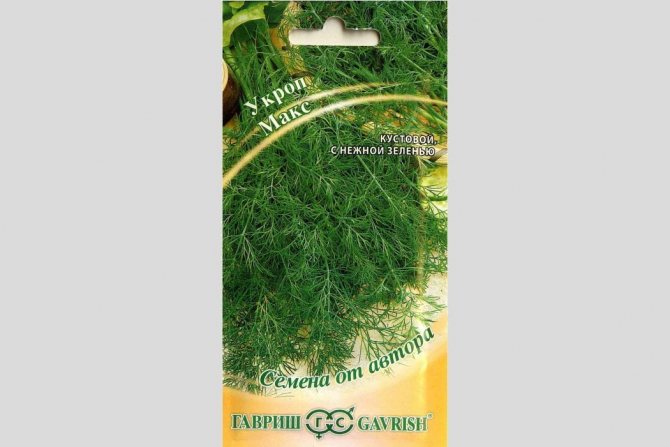

- Umbrella... A hybrid variety with rich green leaves and highly dissected blades. The culture acquires marketable maturity after 40-48 days from seed germination. From 1 sq. m during the season, about 2 kg of greens are harvested.


Mid-late varieties
These crops mature slowly, the process taking about 45-57 days. Popular types include:
- Frost... The bush of this variety reaches a height of 1.7 m, has large convex umbrellas. From 1 sq. m during the season, about 2.7 kg of greens are harvested.
- Borey... The greens are cut 39-55 days after seed germination.The stem reaches 1.2-1.3 m in height. The dignity of the variety is resistance to disease. During the season from 1 sq. m collect up to 4.2 kg.
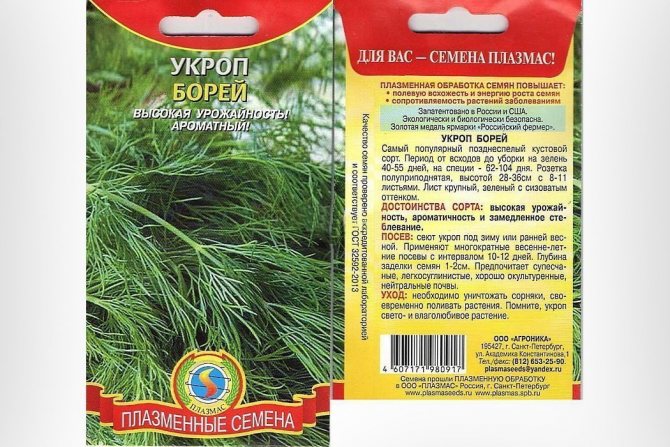

In total, about 70 varieties of dill are known. To provide themselves with juicy fresh herbs for the whole season, gardeners recommend planting several varieties of this culture at once with different ripening periods.
Material selection
Where to get?
Planting material of various varieties of dill can be purchased in specialized stores or ordered on the Internet. When buying, you should pay attention to the characteristics of the variety - the recommended sowing time, yield, purpose. The price of seeds varies, depending on the variety:
- in Moscow from 40 to 150 rubles per package;
- in St. Petersburg - from 30 to 120 rubles.
How to prepare?
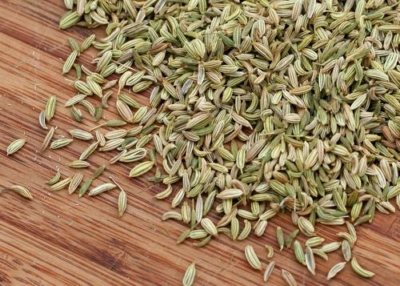

- Wrap the seeds in cheesecloth and soak for three days in water at a temperature of about +45 degrees. The settled water must be drained up to five times a day. This technique will help disinfect the seeds and speed up germination.
- After processing with hot water, put the seeds on the same gauze and cover with pieces of damp cloth. Leave for four days at a temperature of +20. You need to wait until the sprouts appear.
- Dry the seeds before sowing.
Such preparation will allow you to get the first green seedlings in 4-6 days. Seedlings of untreated seeds will appear only after 2-3 weeks.... Also, pre-planting treatment increases plant immunity and ensures seed disinfection.
Origin of the plant name
Dill from the umbrella family received its scientific classification in 1753: Anethum (lat), which means fragrant, burning. Old Russian synonyms for this word are "copr", "krop". The old words fell out of use long ago, but the word "dill" generated by them remained. By the way, in Ukrainian it is called "krip", which is very close to the Old Russian pronunciation.
There is another version of the name: when used, dill is finely chopped, crumbled, and used to say sprinkle, hence the "dill". The author likes the first version.
Most people, when asked what "dill water" is made of, without hesitation, will answer that from dill seeds. But no, - from a 1% solution of fennel oil, which looks very similar to dill, a plant also from the umbrella family.
How to prepare a garden bed
The plot begins to be prepared in the fall. When choosing a place, the peculiarities of this culture are taken into account. Dill, like any other greenery, loves the sun. Ineffective planting in the shade near buildings - the plants do not develop well and the leaves acquire a yellow tint. An equally important condition is the presence of nitrogen in the soil (poor soils are improved with humus or compost).
Preparatory work in the garden begins in the fall. The soil is loosened to a depth of 25 cm using a bayonet blade or a pitchfork. For digging, add 3 kilograms of humus (per 1 square meter of area). Clay soil is "lightened" with sand or dry sawdust.
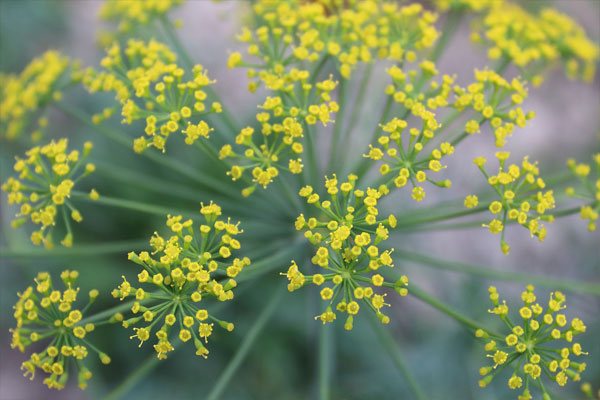

What size bed should I make? Any length is suitable, but the width should be no more than 1 meter. Taking care of plants in a wide bed is very, very difficult. Do a maximum of 70 cm. The height of the ridge depends on the climate - in arid regions, 10 cm is enough, and in humid climates, dill grows well in high beds (up to 30 cm).
Why dill does not grow
For most gardeners, dill grows abundantly, multiplying by self-seeding, and in some areas it does not even emerge. The reasons for the failures must be sought in the composition of the soil and in the violation of agricultural cultivation techniques. The main factors for poor growth of greenery:
Acidic soil
Umbrella crops prefer neutral soil with a pH of 6.5-7. The increased acidity of the soil retards the germination of dill seeds and the growth of seedlings. The culture does not assimilate many microelements, it suffers from nutritional deficiencies. To reduce acidity, dolomite flour, lime or wood ash is added to the soil. It is advisable to add deoxidizing substances in the fall during the preparation of the garden.
Greens grow poorly on heavy, dense soils.In this case, the lack of air affects. Before sowing, it is advisable to improve the structure of the earth by introducing peat, sand, compost.
Advice. Horsetail will help determine the type of soil, the grass grows in areas with high acidity.
Wrong location
Dill categorically does not tolerate the shade, it grows stunted, the stem is stretched, the leaves turn yellow. For greenery, you need to find a well-lit place. It takes 12-14 hours of daylight hours. Do not count on a bountiful harvest under the crown of a tree. The place may be unsuccessful because of the neighbors. Not all vegetables are compatible with each other. It is not recommended to plant herbs next to tomatoes, carrots and basil.
Lack of watering
Improper care is a common cause of poor harvests. Spicy greens are a moisture-loving plant; with a lack of watering, the leaves curl and turn yellow. In hot summer weather, it is recommended to irrigate the greenery 2-3 times a week.
Poor quality seeds
The germination rate of dill seeds is 55-60%, and if stored improperly, it becomes even less. Greens do not emerge if the planting material is damp and moldy. The reason for the low germination rate can be unripe or poorly dried fruits. The shelf life of seeds is 2-4 years, it is better not to use old material. Dill germinates for a long time in dry soil or in case of excessive deepening. For seedlings to appear in 7-14 days, it is necessary to soak the seeds for 2-3 days, water the grooves, and plant the culture to a depth of no more than 2 cm.
Nutrient Deficiency
The dense green foliage of dill pleases gardeners, but it does not exist on poor soil. In order for the greens to grow juicy, fragrant, it is necessary to fertilize the garden in the fall. Humus and compost are introduced into the soil, the recommended rate is 5 kg per sq. m. In addition to organic matter, the garden needs minerals: urea, phosphorus and potassium fertilizers. They are added during autumn preparation or spring cultivation. On poor soil, plants are fed during the growing season. Full information on fertilization in the article "How to feed dill so that it grows better from year to year."
Advice. When growing dill at home, the crop often does not grow due to lack of light. It is necessary to arrange additional lighting in advance by installing fluorescent lamps.
Growth problems arise in crops affected by diseases or pests. Most often, greens suffer from aphids. The insect sucks out the juice of the dill and spreads fungal infections. Read about the ways to combat aphids in the article "In the fight against pests of dill, you will come out victorious."
Experienced gardeners have noticed that greens planted before winter grows and develops better. The seeds undergo natural stratification, become hardened, and increase immunity. The seedlings of such dill are friendly, the foliage is thick and juicy.
Modern use of dill
Today, dill is an important garden crop in almost all agricultural regions of the world. Since it is very unpretentious to growing conditions, it is eagerly bred by both large-scale agricultural enterprises and ordinary residents of rural areas for their own needs.
It is a cheap and widely available spice that is added to many dishes. Dill is used both fresh and dried or salted. Fresh dill leaves and stems are commonly added to hot and cold dishes and salads. Blooming buds or even ripe buds are often used when canning vegetables and making aromatic sauces or seasonings. The phytoncides contained in dill not only give canned vegetables a specific flavor, but also prevent mold.
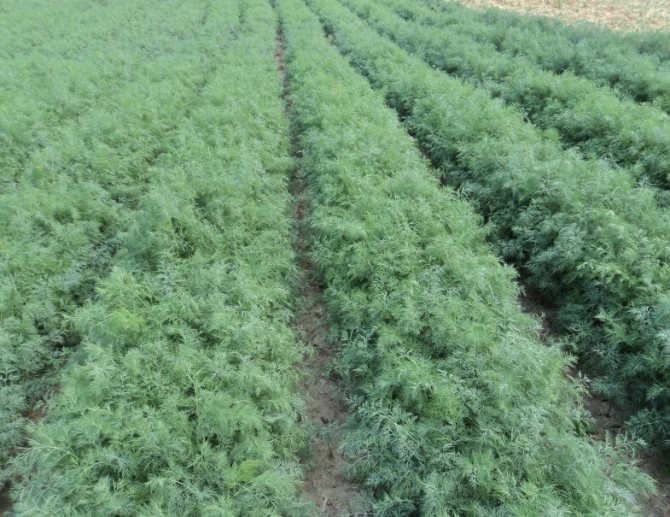

Dried shredded dill is a standard flavoring for many convenience and packaged foods, such as chips and croutons. The essential oil obtained from dill is also used in the food industry.In particular, it is used in the manufacture of food additives, including canned food, as well as in the production of alcoholic beverages.
The medicinal properties of dill have been proven by science, so this plant has found application in medicine. For example, dill tincture is recommended as an adjuvant for hypertension, as well as a diuretic. Essential oil and seeds are a natural and safe sedative and antispasmodic agent. Seed tincture is recommended as an anti-hemorrhoidal agent (for internal use) and as a wound healing agent, including against allergic rashes (for external use).
Dill is used to create pharmaceuticals used in clinical medicine.
As for the perfumery and cosmetic industry, it uses both aromatic and medicinal properties of dill. Creams, soaps, colognes, toothpaste - these and other products are often made with the addition of certain substances derived from dill.
Where to sow correctly to get a good harvest?
The place for planting dill seeds should be sunny... Adequate light will provide plants with healthy growth and juiciness. Shaded bushes stretch out, have a pale color and lose some of their useful properties.
The soil should be neutral and loose. Dill growing on acidic soil becomes reddish, and on alkaline soil it becomes yellow. In both cases, the plant develops slowly, with the result that the possibility of collecting spicy greens is delayed.
Do not sow dill in areas where water often stagnates or where groundwater is close to the surface.
Diseases and pests
A feature of dill plants is a strong susceptibility to powdery mildew. Various varieties are more or less susceptible to this fungal disease. The main control measure is prevention. The complex of preventive measures includes:
- choosing a sunny landing site;
- regular watering and loosening;
- non-thickened crops;
- observance of crop rotation.
Fungicides can only be used on plants that are grown for seeds. If the cutting is carried out less often than once a week, then the garden bed can be treated with 1% copper sulfate. Of biological preparations, Alirin B is suitable. If blackening of the shoots is noticed, then the plants are affected by another fungal disease - phomaosis.
Of the pests on dill, bugs and some types of aphids can settle. To combat them, mechanical removal should be used and the pests should be washed off with a strong stream of water.
Choosing seeds
In stores for gardeners, seeds for planting dill are sold in huge quantities. They differ among themselves by the type of plant. Depending on this or that variety, you will get shoots of different lengths, different volumes, and most importantly, different taste properties of the plant.
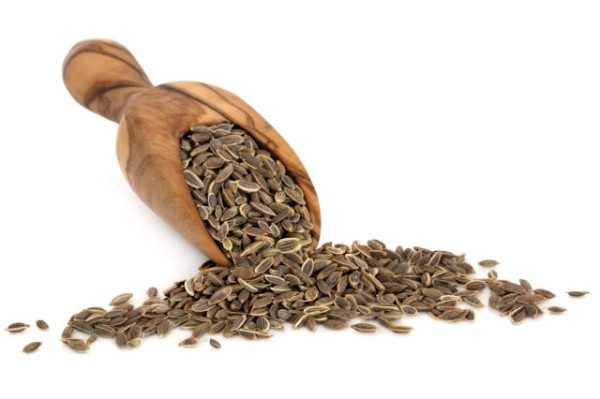

Seed selection is an important point before planting.
Choose only the variety that is right for your type of land and weather conditions. To do this, you need to familiarize yourself in more detail with the planting conditions on the back of the packaging label.
Also, do not forget that for planting in open ground, you only need to purchase certain seeds. For growing on the windowsill, there are certain varieties that require a milder climate and careful care.
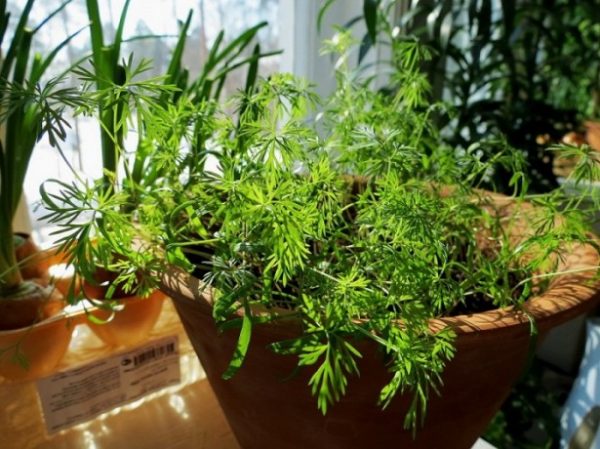

Dill on the windowsill
You can also use the seeds of last year's dill. But for this they must meet several conditions at once.
- first, they must be well dried. It is important that the seeds do not start to rot, otherwise, you will get a meager harvest;
- secondly, the seeds should not be damaged by rodents and other mechanical traumatic effects.
Before planting, they need to be properly prepared, and how, much depends on the variety. You can only plant seeds if you know which particular variety they belong to.This way you can provide the most appropriate care and create conditions for growth and development.
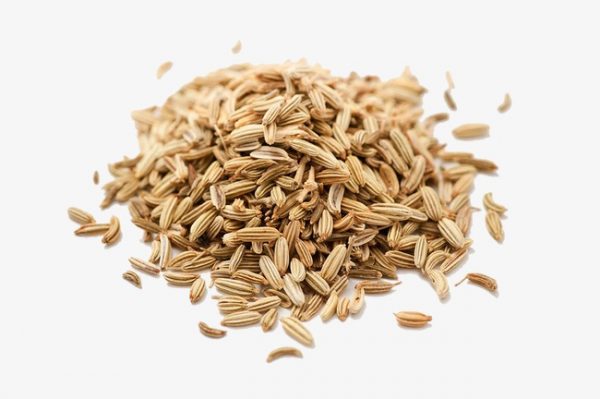

Different varieties suggest different seed shapes
Table 1. Pros and cons of store seeds.
| pros | Minuses |
| Shop seeds do not need to be prepared in advance. | Buying seeds is like buying a pig in a poke. You cannot know for sure whether the desired variety has been sold to you, and you also have no idea whether the seeds will be accepted or not. |
| They are inexpensive. | Some unscrupulous growers do not seek to put only seeds suitable for planting in the bag. Their goal is to get rid of marriage. |
| The care instructions are directly on the packaging. | Another disadvantage is the cost. If you are going to grow dill in large batches, then buying seeds in large quantities is unprofitable and quite costly. But there is a high probability that many seeds simply will not germinate. This means that the money will be wasted. |
Only you can decide what seeds are needed to purchase and plant on your site.
When is the best time to plant, recommendations depending on the season: spring, summer, autumn
When to plant greens and can it be done in the summer? It is possible to sow dill planting material in open ground from early spring to late autumn.
Below are a number of recommendations, also with regards to sowing dates, which are useful for both experienced gardeners and beginners.
- In the spring dill seeds begin to germinate at a temperature of +3 +4 degrees. Therefore, they can be sown immediately after the snow melts and the soil thaws. Further, the seeds are sown every two weeks in order to obtain a constant formation of fresh greens.
- In autumn the seeds are sown after the temperature has stabilized at a level below +3 degrees, so that they do not germinate. It is best to mulch the plantings so that a crust does not form on the soil during the winter, through which it will be difficult for seedlings to break through. It is believed that dill sown in the fall is more hardy and resistant to most diseases.
- Summer crops give poor results without preliminary seed preparation. Extreme heat has a negative effect on the growth of dill. But plants planted in the summer are best for getting umbrellas.
What kind of soil does dill like
Greens grow remarkably in fertile soils rich in organic fertilizers. Before planting the plant, it is recommended to add a small amount of humus or fertilize the soil with a solution of mullein, bird droppings. Of chemical fertilizers, it is good to add the following:
- saltpeter;
- superphosphate;
- potassium group.
The plant does not tolerate acidic soil, therefore it will not be possible to get a crop. If there is no other choice, then all measures must be taken to reduce acidity.
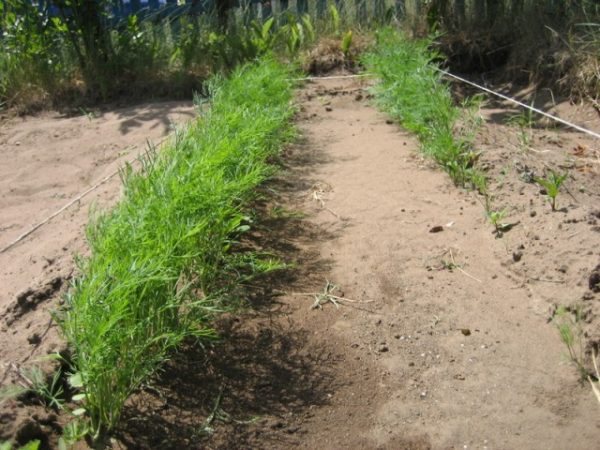

Dill bed in the garden
Where is the best place to grow greens? She loves sunny beds with lots of sunshine. However, direct hit of rays on it is undesirable, since appetizing greens can spoil its appearance with burns.... It is also advisable to avoid drafts. But the plant is not demanding about its neighbors: it can get along well next to any crops.
Summer residents say that many of them grow dill right in the beds with potatoes, onions and carrots. True, in this case it is necessary to ensure that the landings do not create wilderness for each other.
Detailed step by step instructions
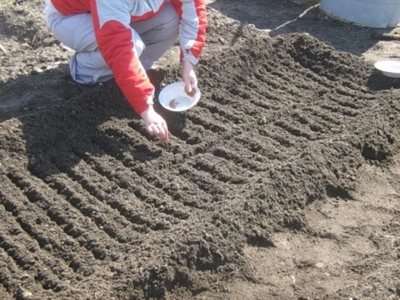

- The place prepared for landing is marked out. With a wooden stick or plank, grooves are formed, two centimeters deep, at a distance of twenty centimeters from each other.
- The depressions are sprinkled with water moderately and the planting material is sown. An interval of 1-2 cm must be observed between seeds.
- The sown rows are covered with slightly damp soil.
- If planting is carried out before winter, then the grooves are not watered before sowing.
In addition to the classic planting pattern in rows, you can apply the carpet pattern... This method will allow you not only to get a harvest of dill, but also to decorate the site with a lush green blanket.To do this, the seeds are evenly scattered over the selected area and covered with a rake. After that, the soil is watered abundantly.
From our individual publications, you can learn more about the nuances of growing dill outdoors:
- How to grow seedlings correctly?
- How quickly does dill rise and what does it depend on?
- After what crops does the plant grow well in the soil?
- Is it necessary to soak the seeds?
How to sow dill so that it sprouts quickly
Herb seeds are rich in essential oils and organic acids. These characteristics make them a useful medicinal raw material and aromatic culinary seasoning. Essential oils prevent moisture from getting inside the fetus, slowing down the biological processes of sprout development. After planting, gardeners have to wait for the greenery to appear for about three weeks. What to do with hard-like seeds? The main advice is to partially wash out the oils. Complete information about the peculiarities of the fruits of the spicy culture in the article "Versatile dill - useful properties of seeds both in medicine and in cooking".
Experienced farmers know several methods on how to accelerate the germination of dill. Work with planting material begins a week before sowing. It must not only be soaked, but also disinfected before sowing in open ground. Fungal and viral diseases are in most cases transmitted with contaminated seed.
Information. The best germination is with seeds harvested 1 year before sowing. If the storage rules are violated, the planting material loses its quality.
Dill seed treatment methods for fast germination:
- Soaking in warm water. The easiest and most affordable option is to place grains of spicy herbs in warm water for 2-3 days. The liquid must be filtered or settled. These procedures will remove chlorine from the tap water. The chemical element has a negative effect on plants. For convenience, the seeds are poured into a bag of gauze or cotton cloth. The water is changed 4-5 times a day. Each time a liquid is poured at a temperature of 20-22 ° C.
Advice. Hot water (55-60 ° C) acts more effectively on essential oils. The time spent in it is limited to 2-3 minutes.
- Dill does not need to be kept in a lot of water. After soaking and regularly changing the liquid during the day, it is placed in a wet napkin. The room where the seeds are swelling should be warm. As it dries, the napkin is moistened with water.
- Immersion in a solution of growth stimulants. One of the popular ways to quickly germinate dill is by placing it in a solution of biological stimulants "Epina", "Zircon", "Kornevin". The drugs activate the development of the embryo, strengthen the plant's immunity. They are diluted in water according to the manufacturer's instructions. The substances in the stimulants accelerate the pecking of the roots.
- The ash solution serves as a substitute for growth biostimulants. Its action is based on the content of a large amount of trace elements (especially potassium and calcium) in the ash. The substance is poured into hot water (2 tablespoons per 1 liter) and insisted for 2 days, stirring occasionally.
- Soaking in vodka before planting. Ethyl alcohol dissolves essential oil perfectly. Seed material treated with vodka (40% alcohol solution) demonstrates rapid germination. The procedure should not exceed 15 minutes. Alcohol not only dissolves the oil, but also has a disinfectant effect.
- One of the natural growth promoters is aloe. The juice of the leaves, diluted with water in a 1: 1 ratio, is used to soak the seeds of aromatic herbs. The composition increases the immunity of the culture.
- Bubbling - air treatment of seeds. At home, the procedure requires a high glass container and a compressor used for the aquarium. During processing, the material is saturated with oxygen, essential oils are washed out of it. The bubbling time is 12-18 hours. The temperature of the water used is 18-20 ° C.After the procedure, in favorable weather conditions, the seeds germinate in 3 days.
- Vernalization is a method that older agrarians know about. The seeds are poured into a tissue bag and buried in the ground for a week.
Seed preparation for sowing will be incomplete without dressing. Pathogenic microorganisms are destroyed by high temperature, alcohol, fungicide solution:
- Manganese permanganate crystals are dissolved in water until the liquid turns pink. The planting material is poured into a bag and immersed in the solution for 20-30 minutes. Then washed with running water.
- Fungicide "Fundazol" is diluted in water according to the instructions. After processing, dill will be protected from many diseases.
- Hydrogen peroxide serves as a substitute for the listed drugs; it has bactericidal properties. The planting material is kept in the solution for 10 minutes.
Information. Treatment of dill seeds with "Fundazol" eliminates the causative agents of powdery mildew, fusarium, rot.
After treatment with stimulants and fungicides, the green seeds are washed with clean water. Before planting, the material is thoroughly dried to restore flowability. It is scattered on paper in a thin layer, stirred periodically to dry evenly. Before planting, the bed is abundantly moistened. To maintain favorable conditions, you can plant the crop under film. The transparent fabric transmits light, but prevents moisture evaporation. With the appearance of the first green shoots, the shelter is removed.
When to collect dill
Dill cutting time depends on its duration and purpose. Early varieties are ready to give the first greens from the garden in 33-35 days. After that, they begin the flowering phase. Spicy umbrellas are left for seeds. They are indispensable for the preservation of cucumbers, zucchini and tomatoes. The seeds are harvested for planting, culinary and medicinal purposes. The stems of the plant are uprooted, the annual crop will not sprout next year.
Advice. Ripe fruits fall off easily, so they are harvested in advance and dried in the shade. In order not to lose the seeds, paper bags are put on the umbrellas.
Mid-season varieties "Kibray", "Richelieu", "Abundant-leaved", "Borey" are universal crops. The bushy form of plants allows you to collect green leaves in large quantities and for a long period. Pruning starts a week later than early dill. By this time, the rosette grows to 15-25 cm. The leaves are harvested, starting from the lower ones. It is better to cut the lateral petioles without affecting the growth points from which new leaves will appear. It is recommended to choose cool weather for collecting greenery.
Advice. Leave some plants for seeds. During the season, do not break off their leaves, then the fruits will be strong and healthy.
How to harvest dill correctly - uproot or cut the leaves? Ordinary plants immediately give an umbrella, so they are plucked out. Shrub late-ripening forms are distinguished by their ability to produce several harvests of leaves. They are carefully cut with sharp scissors. How to collect herbs for spices? It is pulled out of the ground, the roots are cut off, and the stems are tied into sheaves. In this form, they dry for a week. Ripe seeds are threshed and stored in a sealed container.
How to speed up the germination of dill seeds
The seeds germinate slowly, as they are covered with essential oils, which prevent moisture from penetrating into the seed, delaying germination. Germination can be accelerated by soaking the seeds in hot water (not boiling water) - this will cause excess oil to float. When the water cools down, drain it, rinse the seeds with cold water.
I make it easier - I read somewhere that essential oils dissolve alcoholic solutions well - I fill the seeds with vodka (you can't burn them for more than 15 minutes), rinse them, dry them to a loose state, and sow them. Seedlings appear in 4-5 days.
I do such a vodka seed treatment if no rains are foreseen ahead, there is hot weather. This is usually a re-sowing in the second half of the summer.And in early spring, when the soil is moist after winter, there are enough moisture reserves, I sow seeds without vodka treatment - shoots appear in 10-12 days. Seeds do not lose their germination for 3-5 years.
The best varieties of dill for open ground
On a personal plot or in the country, you can grow varieties of early, middle and late ripening. The early ones grow quickly, but do not produce lush greenery. Of the varieties of this group, Gribovsky, Dalny, Redut are known. Alligator, Max, Richelieu are mid-season varieties. Of the later, you can plant, for example, the following: Hoarfrost, Salute, Patterns. They take a long time to grow, but they have the most luxurious greens.
